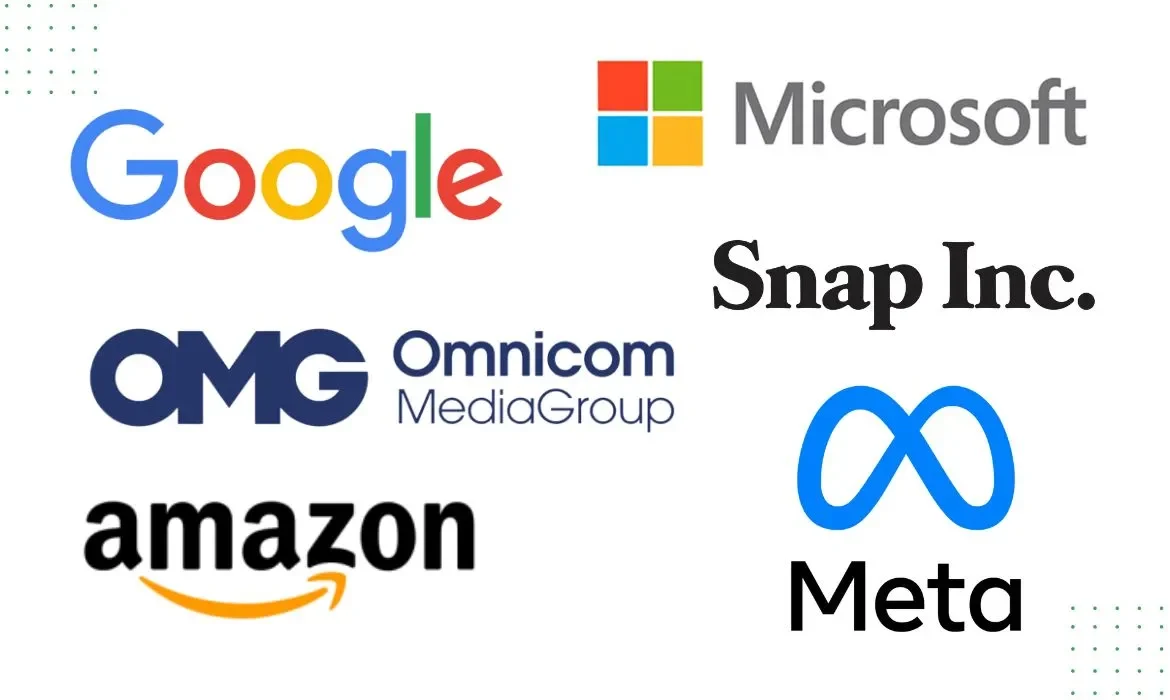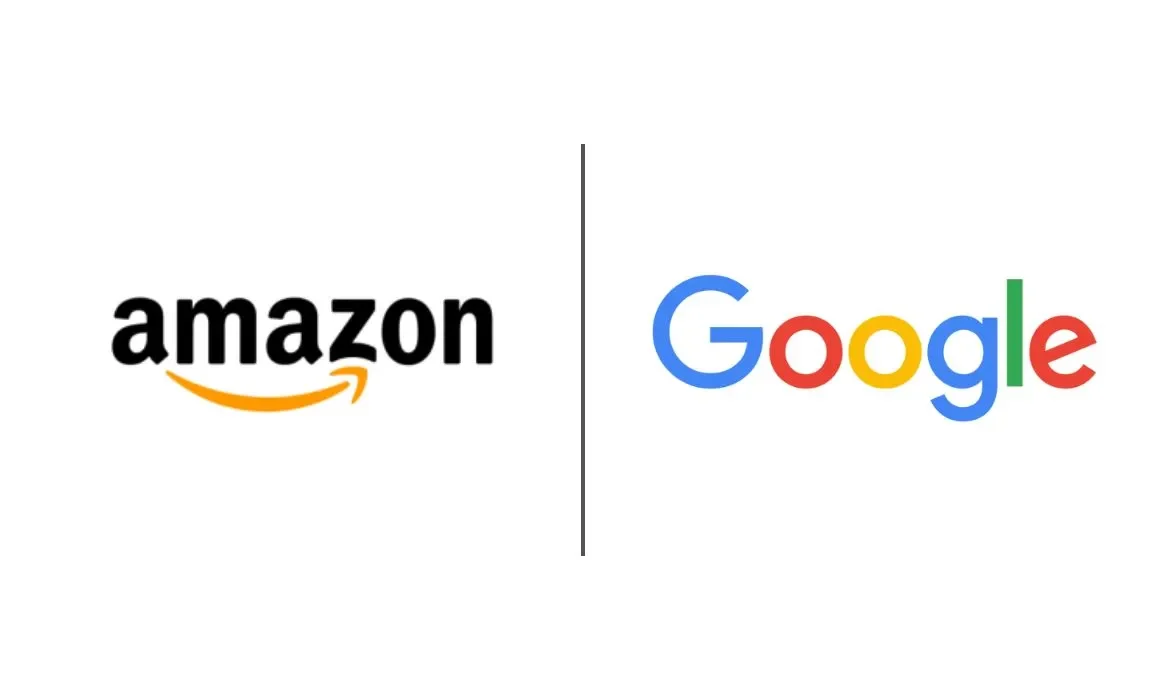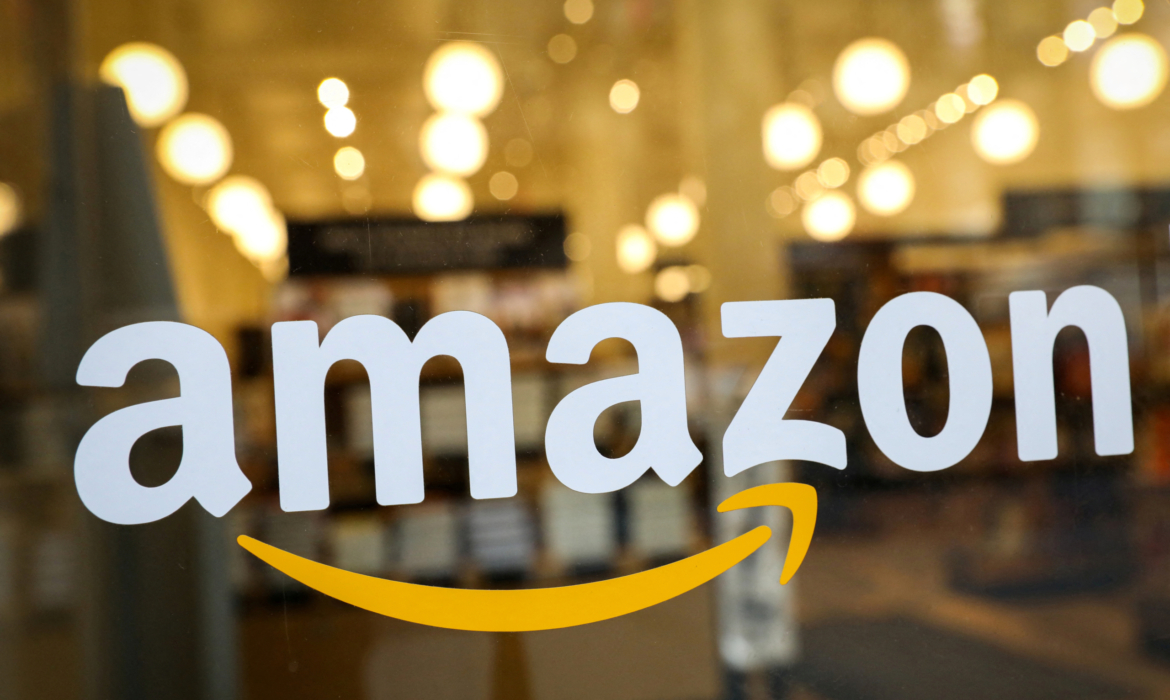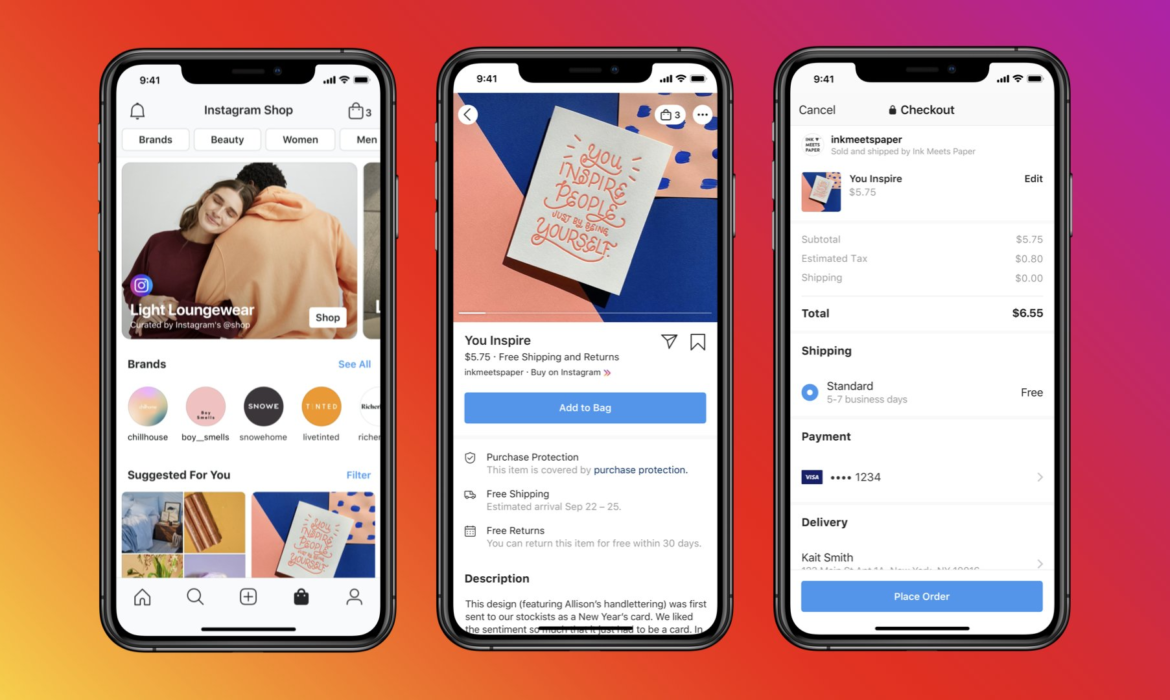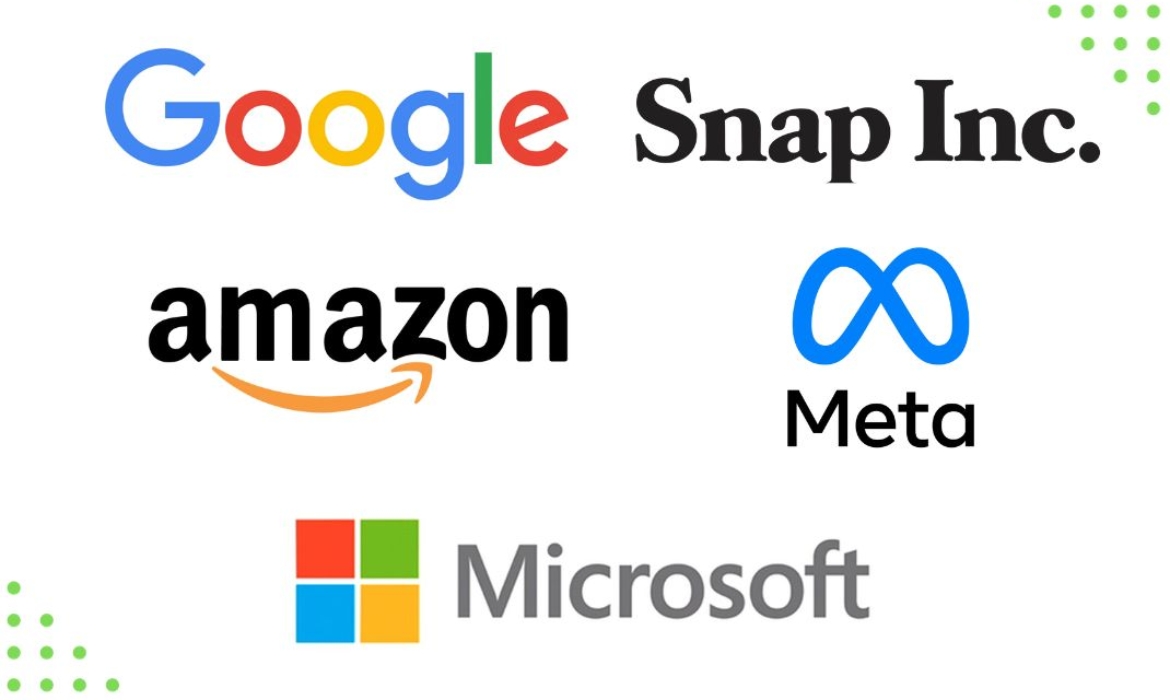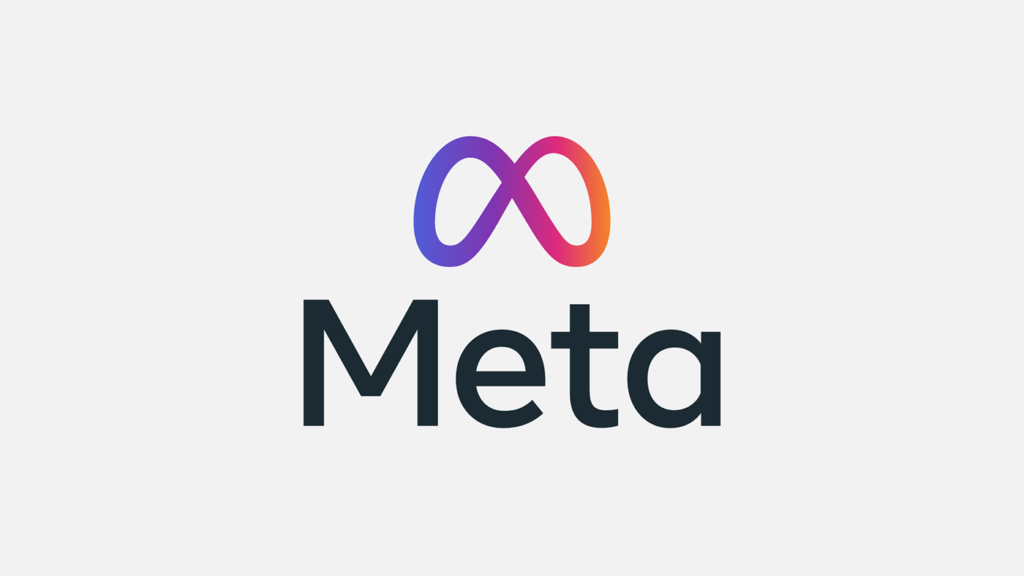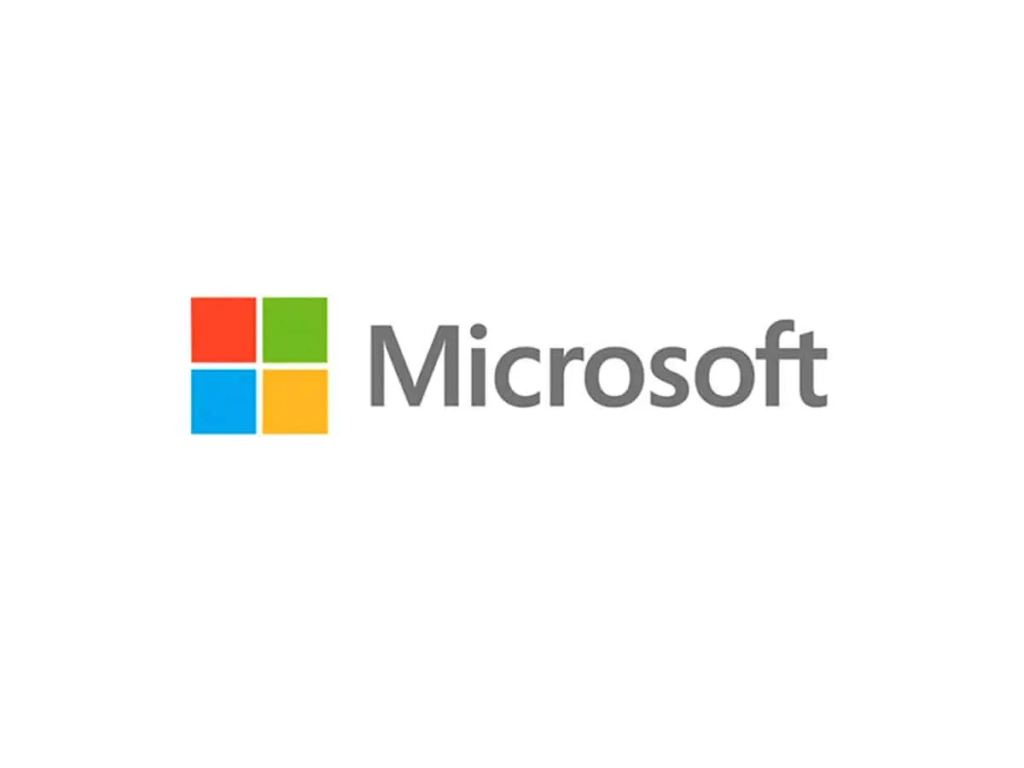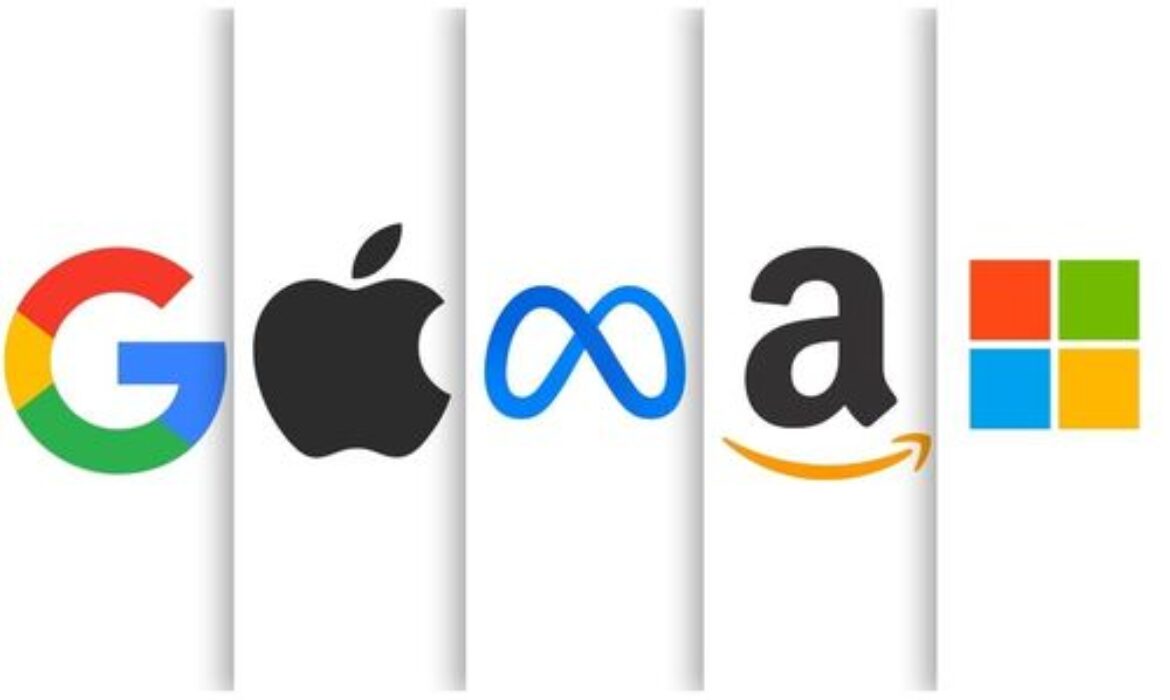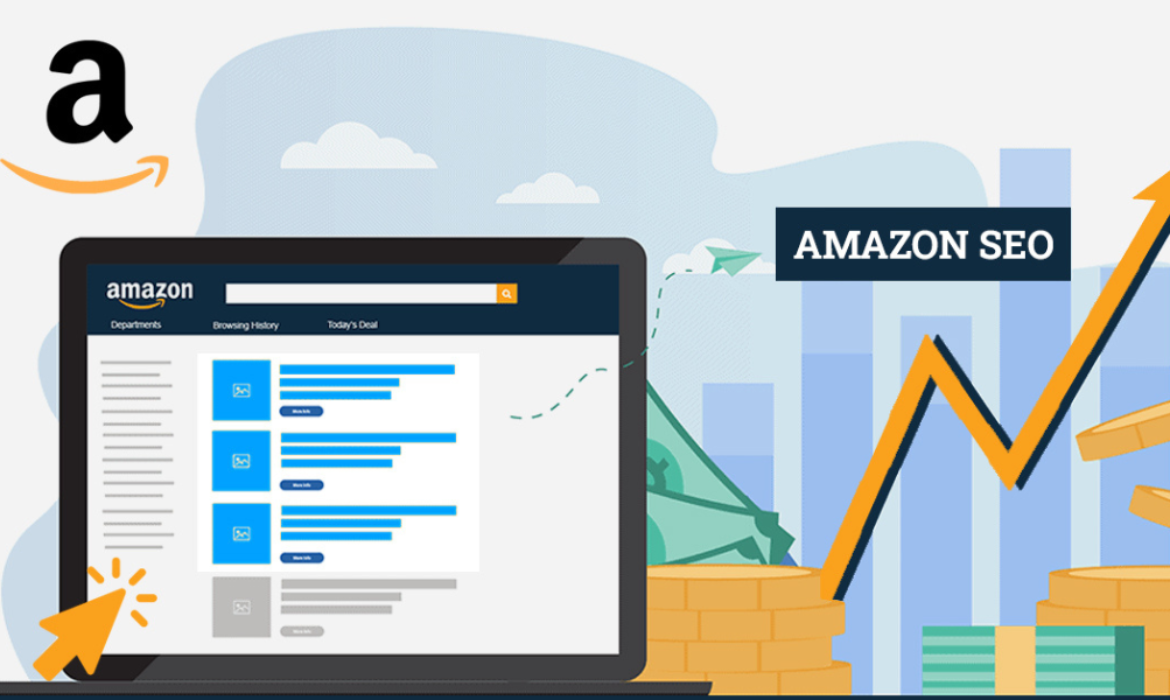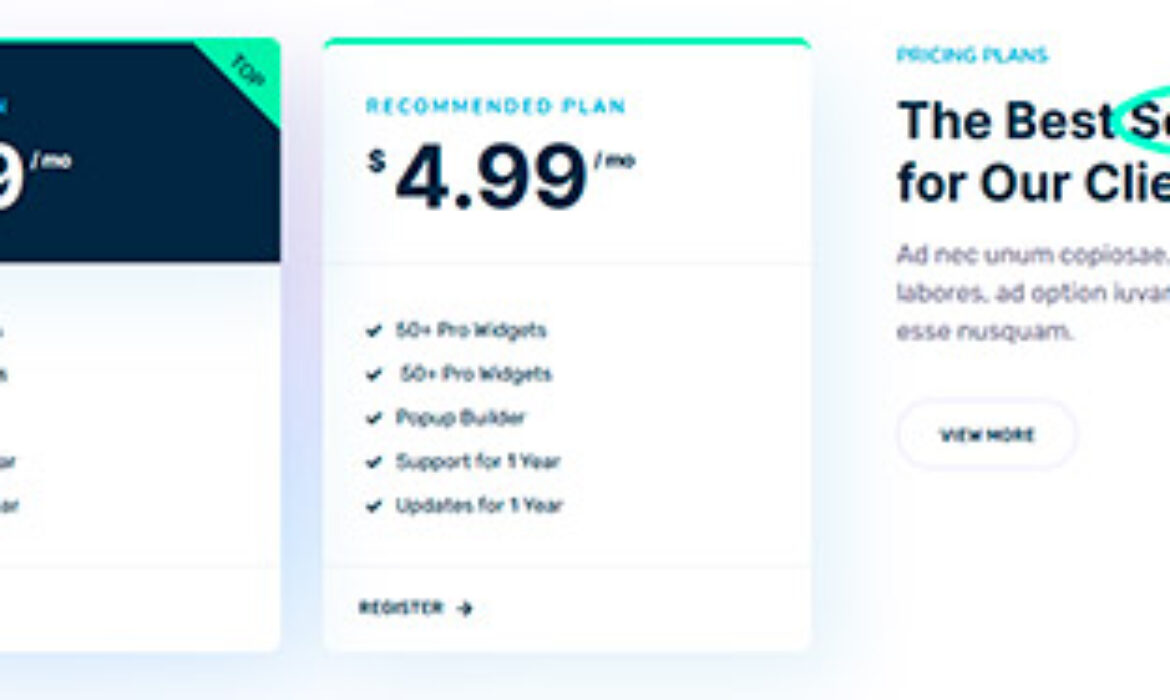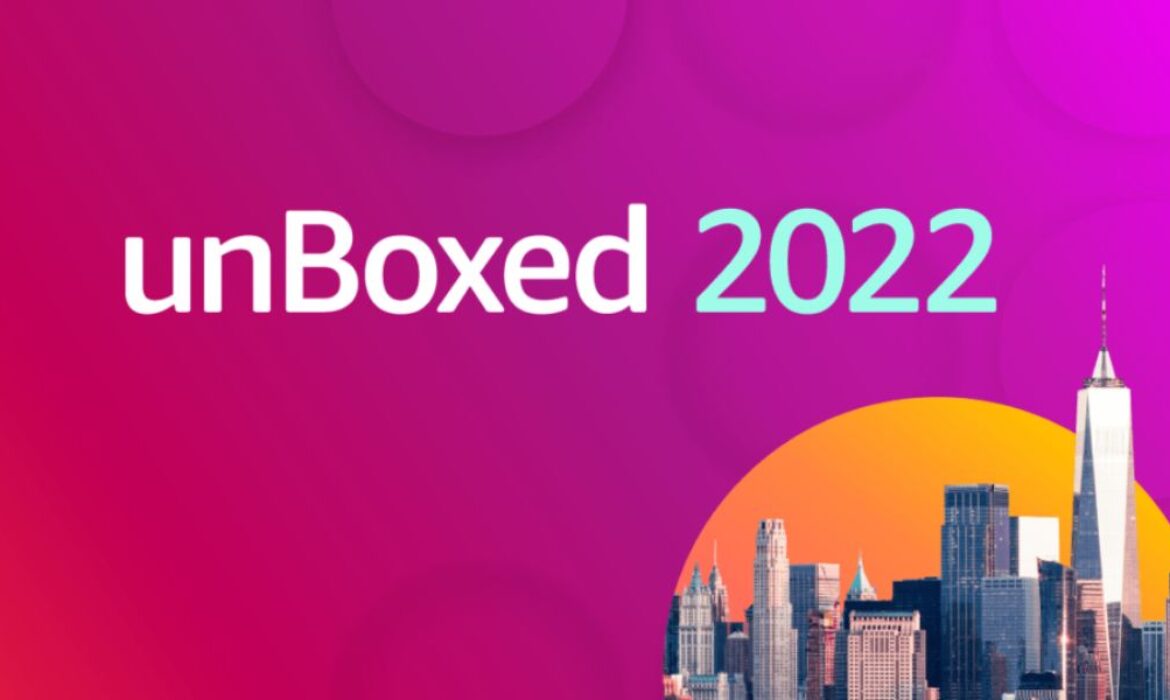Deciphering Big Tech Giants’ Quarterly Results: Here’s What They Say!
The Big Techs recently disclosed their fourth-quarter results. For those who are interested in the industry, these are a few key findings and insights from the quarterly reports.
![]()
ALPHABET
Alphabet Inc., the parent company of Google, exceeded Wall Street forecasts with its fourth-quarterly earnings report. Ad sales, however, failed to expand quickly enough to keep up with experts’ predictions. YouTube, which has been contributing to increased growth, came up barely short of projections. With over 2 billion monthly users and an average of 70 billion views per day, YouTube Shorts continues to be a top priority for Google.
The cloud division, which was losing money for years while it attempted to compete with Microsoft Azure and Amazon Web Services, is where the company makes its money. Google Cloud continued to be a growth engine in the fourth quarter, expanding by 26%. The primary driver of revenue growth continues to be search. While brand and direct response advertising drove YouTube advertising, growth in retail was the main driver of Google Search and other forms of advertising revenue.
By the numbers
- Revenue reported was $86.31 billion, up 13.5%.
- Google Search and other advertising revenues rose to $48 billion, up 13% Yo-Y.
- Google cloud computing revenue was $9.19 billion up 26% Yo-Y.
- Advertising revenues reported were $65.52.
- YouTube advertising reported $9.2 billion, up 16% Yo-Y.
- Network advertising revenue was $8.3 billion, down 2%.
- Traffic acquisition costs were $13.9 billion.
Google is beginning to provide generative AI to an increasing number of companies to assist them in creating more effective campaigns and advertisements. Google unveiled Gemini, a large language model that it claims to be its most powerful AI model, in December. The business intends to license Gemini to users via Google Cloud so they can utilize it in their apps. Additionally, Google plans to test the usage of Gemini in Search, where it will speed up consumers’ Search Generative Experience (SGE).
Sundar Pichai, CEO, said in the conference call,
We are pleased with the ongoing strength in Search and the growing contribution from YouTube and Cloud. Each of these is already benefiting from our AI investments and innovation. As we enter the Gemini era, the best is yet to come.
Ruth Porat, President and Chief Investment Officer, CFO said,
We ended 2023 with very strong fourth quarter financial results, with Q4 consolidated revenues of $86 billion, up 13% year over year. We remain committed to our work to durably re-engineer our cost base as we invest to support our growth opportunities.
Read More: Google Integrates Gemini AI Into Search Ads Platform

META
Meta exceeded Wall Street expectations and had a positive fourth quarter. The positive outcomes show that digital advertising has recovered well from its 2022 decline. It was a significant year for both the business and the community. According to Meta’s estimation, over 3.1 billion individuals use at least one of the Meta applications daily. The already enormous social media company keeps on adding new users across all platforms.
Overall, Meta’s Q4 revenue increased by 25% over the previous year. Threads, the business’s Twitter-like social app that launched in July 2023, now has over 130 million monthly active users, according to the company. As is usual, almost all of Meta’s revenue came from sales of digital advertising. Chinese retailers have increased their spending to reach customers worldwide, which has contributed to Meta’s financial turnaround during the past year. They have been heavily investing in Facebook and Instagram ads.
By the numbers
- Revenue was $40.11 billion, an increase of 25% Yo-Y, and $134.90 billion, an increase of 16% Yo-Y for the full year.
- Facebook DAUs were 2.11 billion on average, an increase of 6% Yo-Y.
- Facebook MAUs were 3.07 billion, an increase of 3% Yo-Y.
- Family DAPs were 3.19 billion on average, an increase of 8% Yo-Y.
- Family MAPs were 3.98 billion, an increase of 6% Yo-Y.
- Ad Impressions delivered across all Meta apps increased by 21% Y-o-Y and the average price per ad increased by 2% Yo-Y.
Strong sales of the company’s Quest device during the holiday season drove record sales of $1.1 billion for the metaverse-focused Reality Labs division. Additionally, Zuckerberg stated that the ad business, which is expanding more quickly than Google, has benefited from advancements in artificial intelligence. By the end of the year, Meta plans to completely launch Meta AI assistant and further AI chat experiences in the United States using generative AI.
Meta Chief Executive Mark Zuckerberg said in a news release,
We had a good quarter as our community and business continue to grow. We’ve made a lot of progress on our vision for advancing AI and the metaverse.
Susan Li, CFO, stated that Meta’s big areas of focus in 2024 will be working towards the launch of Llama 3, expanding the usefulness of Meta AI assistant, and progressing on our AI studio roadmap to make it easier for anyone to create an AI.
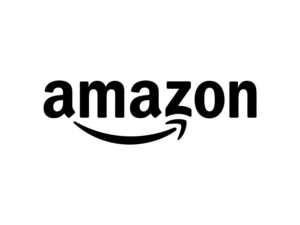
AMAZON
For the fourth quarter of 2023, Amazon reported better-than-expected revenues, exceeding sales forecasts thanks to new generative AI capabilities in its cloud and e-commerce businesses, which drove strong growth throughout the Christmas season. The e-commerce behemoth had a great holiday season. Over 1 billion items were bought on the site in the course of the company’s 11-day Black Friday and Cyber Monday sales. Additionally, the events helped bring in new Prime members and save consumers billions of dollars.
With 26% Yo-Y growth in worldwide advertising, Amazon had a great result. Because machine learning has improved ad relevancy, sponsored products have been the main driver of advertising strength. The shift in customer attention towards encouraging innovation and introducing new workloads to the cloud was attributed to the increase in AWS revenues.
By the numbers
- Revenue was reported at $169.9 billion versus expectations of $166.2 billion, up 13.9% Yo-Y.
- AWS Revenue 13% increase in sales over the prior year to a total of $24.4 billion.
- Advertising sales of $14.7 billion.
- Subscription services were up 13%, reporting $10.4 billion in revenue.
Amazon has launched Rufus, a new AI shopping assistant trained in Amazon’s product catalog and other web-based information. The tool, driven by generative AI, may provide product recommendations and respond to queries from users of the Amazon mobile app. The corporation believes that advancements in AI might bring in tens of billions of dollars for its cloud computing division.
Chief Executive Andy Jassy said in Amazon’s press release
This Q4 was a record-breaking holiday shopping season and closed out a robust 2023 for Amazon. While we made meaningful revenue, operating income, and free cash flow progress, what we’re most pleased with is the continued invention and customer experience improvements across our businesses.
Amazon’s Chief Financial Officer Brian Olsavsky added,
We’re coming off a period where we’ve done a lot of hiring. There’s a general feeling in most teams that we’re trying to hold the line on headcount.
Read More: Amazon and Reach Partner for Targeted Ads Ahead of Third-Party Cookie Phase-Out

MICROSOFT
Microsoft had a record-breaking quarter, mostly due to Microsoft Cloud’s ongoing growth. Strong executions in the commercial areas and device advancements were credited for the anticipated growth in its quarterly results. The robust demand for Microsoft Cloud offerings, particularly AI services, led to enhancements in Azure, which in turn drove revenue growth.
On October 13, 2023, Microsoft completed the acquisition of Activision Blizzard. With the acquisition, the business expanded its player base by hundreds of millions. It broke previous records for MAUs on Xbox, PC, and mobile devices with over 200 million MAUs in a single month. The business has been integrating AI into every aspect of the IT stack, bringing in new clients and fostering increased efficiency. Additionally, the business reported increased revenue from Windows OEM sales and improved performance in consumer markets.
By the numbers
- Revenue recorded was $62.0 billion, an increase of 18%.
- Intelligent Cloud unit $25.9 billion, increasing 20% ahead of expectations.
- Azure revenues increased by 30%.
- LinkedIn’s revenues increased by 9%.
- Microsoft Cloud Revenue was $33 billion, up 24%.
- Search and news advertising revenue excluding traffic acquisition costs increased by 7%
AI is helping to drive revenue in the Azure consumption business. Over the past year, Microsoft, Amazon, and Google have all invested billions of dollars in artificial intelligence (AI) in an attempt to overtake one another as the leading providers of AI software.
Satya Nadella, chairman and chief executive officer of Microsoft said,
We’ve moved from talking about AI to applying AI at scale. By infusing AI across every layer of our tech stack, we’re winning new customers and helping drive new benefits and productivity gains across every sector.
Amy Hood, Chief Financial Officer added,
While it’s early days for Microsoft 365 Copilot, we’re excited about the adoption to date and continue to expect revenue to grow over time.
Read More: Vodafone and Microsoft Sign 10-year Strategic Partnership for IoT, Cloud, AI and More
APPLE
In its first-quarterly report, Apple exceeded analysts’ projections for both revenue and profits, but it revealed a 13% drop in sales in China, one of its most significant regions. The tech giant surpassed 2.2 billion active devices, setting a new milestone for its installed base. Apple attributes this to extremely high levels of customer satisfaction and unmatched customer loyalty.
According to projections, Mac sales increased by less than 1% throughout the quarter. Nonetheless, this is a noteworthy comeback for the product line, which had an annual decline of about 34% in the September quarter. iPad sales are still declining. For the first time in iPad history, Apple did not introduce a new model in 2023.
By the numbers
- Revenue was $119.6 billion, up 2% Yo-Y.
- iPhone Revenue was $69.70 billion 6% up.
- Mac $7.78 billion 1% up Yo-Y.
- iPad $7.02 billion down 25% Yo-Y.
- Wearables, home, and accessories revenue was $11.95 billion, down 11%.
- Service Revenues $23.13 billion up 11% Yo-Y
Additionally, Apple unveiled the Apple Vision Pro, their most sophisticated personal electronics gadget to date. Customers in the United States will be able to purchase it via Apple stores; later in the year, it will also be available in other countries. It is considered a groundbreaking gadget that is years ahead of anything else and is based on decades of Apple ingenuity. Additionally, the company announced that customers may select any Apple Watch model that is carbon neutral for the first time.
Tim Cook, Apple’s CEO said in the conference call,
Today Apple is reporting revenue growth for the December quarter fueled by iPhone sales, and an all-time revenue record in Services. We are pleased to announce that our installed base of active devices has now surpassed 2.2 billion, reaching an all-time high across all products and geographic segments. And as customers begin to experience the incredible Apple Vision Pro tomorrow, we are committed as ever to the pursuit of groundbreaking innovation — in line with our values and on behalf of our customers.

SNAP INC
Snap Inc. released a forecast that was slightly below Wall Street expectations. The company has now recorded six consecutive quarters of single-digit growth or revenue contraction. Snap Inc. struggled to recover from the downturn in the digital ad sector.
Snap Inc. has announced a new publisher partnership with Spotify in the United States, which will bring short-form highlights from Spotify’s podcasts to Spotlight and Stories. Additionally, the social media giant revealed new AI-powered tools for Snapchat+ users, enabling them to edit and share Snaps as well as create and send AI-generated images in response to text prompts.
By the numbers
- Revenue was $1,361 million, an increase of 5% Yo-Y.
- DAUs were 414 million, an increase of 39 million or 10% Yo-Y.
- MAUs increased 8% Yo-Y and surpassed 800 million in Q4.
- Subscriptions for Snapchat+ have reached over 7 million
Snapchat made a large investment in its augmented reality system. On average, almost 300 million Snapchat users use its augmented reality feature every day. Additionally, it has invested in automation and technology, used generative models, and optimized the ML Lens generation workflow.
Evan Spiegel, CEO said in the announcement,
2023 was a pivotal year for Snap, as we transformed our advertising business and continued to expand our global community, reaching 414 million daily active users. Snapchat enhances relationships with friends, family, and the world, and this unique value proposition has provided a strong foundation to build our business for long-term growth.
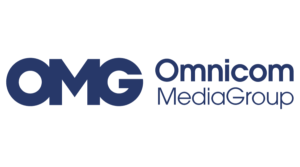
OMNICOM MEDIA GROUP
Omnicom exceeded analyst forecasts with impressive Q4 and full-year 2023 results. The growth in advertising and media during the quarter was driven once again by the performance of global media, with softer results from Omnicom’s advertising agencies serving as a partial offset.
Additionally, Omnicom completed the acquisition of Flywheel Digital, which will contribute to the introduction of scaled capabilities in the retail, media, and digital commerce sectors—the fastest-growing areas of the business. Furthermore, Omnicom disclosed that it has partnered with Getty Images as a first mover, giving them early access to a new generative artificial intelligence tool.
By the numbers
- Revenue reported increased $192.7 million or 5% organically, to $4,060.9 million.
- Advertising and media were up 9.3%.
- Public Relations was 2.9% down.
- Third-party service costs increased by $97.5 million or 12.4% to $884 million
Omnicom has reportedly spent tens of millions of dollars developing artificial intelligence over the past ten years, according to CEO John Wren. With the recent June 2023 launch of Omni Assist, a generative AI-powered virtual assistant that organizes, carries out, and produces advertising campaigns through cooperation with Microsoft, Omnicom became the first agency holding company to get access to the most recent Open AI GPT models.
John Wren, Chairman and Chief Executive Officer of Omnicom commented,
Omnicom finished 2023 with 4.4% organic revenue growth in the fourth quarter and 4.1% for the year. Looking out to full year 2024, we are set up well with solid fundamentals, tremendous opportunities in digital commerce and retail media from our Flywheel acquisition, and momentum in new business wins. Our accelerated investments in analytics and AI will enhance our ability to drive the best outcomes for our clients, while shareholders remain supported by our profitable operations and balanced deployment of capital through dividends, acquisitions, and share repurchases.
Read More: Decoding Big Tech Giants Quarterly Results: Insights Await!
Amazon and Reach Partner for Targeted Ads Ahead of Third-Party Cookie Phase-Out
Amazon has signed a historic contract with Reach, the UK’s largest publisher, to access customer data for targeted advertising. The collaboration occurs as the media landscape struggles to respond to Google’s move to remove tracking cookies from its browser. Reach will share “contextual” first-party data with Amazon under the terms of the agreement, including details about the articles users are viewing. Amazon will then make use of this information to improve targeted ads on the websites of U.K. publishers, giving advertisers more effective and relevant advertising options.
The agreement benefits in ad data for targeted ads
The agreement is a reaction to Google’s plans to phase out third-party cookies later this year. It is among the first of its kind in Europe. Google plans to turn off all third-party cookies by the end of the year, matching Apple’s similar action to prohibit them in Safari. Its goal is to compensate for the disappearance of cookies, which monitor users’ online activities and gather data about them to better target advertisements. However, the agreement’s financial details were kept secret. Reach announced that it would collaborate with Amazon to share first-party data that is “contextual,” such as what articles users are viewing, with the American tech company utilizing the data to offer more specialized advertising on the U.K. publisher’s sites.
Beyond third-party cookies for targeted ads
This deal inspires other ways to reach high-value consumers online as advertisers look beyond third-party cookies for targeted advertising. To make sure that advertisements appear next to content that users are interested in, Reach intends to make use of Mantis. It is a brand safety and contextual advertising tool for publishers. By working together, Amazon can more effectively target audiences with relevant advertising in Reach’s magazines, including the Mirror, Daily Star, and OK! Magazine.
Read More: Amazon Prime Video Estimated to Generate $1B From Ad-Supported Tier in Debut Year
U.K.’s CMA raises safety concerns
While Reach and Amazon were announcing their partnership, the U.K. Competition and Market Authority (CMA) sent out a statement stating Google cannot move forward with third-party deprecation. The CMA raised issues that might cause Google’s third-party cookies phase-out to be delayed. In its most recent report on Google’s Privacy Sandbox, the tech giant was found to have complied with commitments. However, there are still several issues that need to be resolved before third-party cookies are removed from Chrome. If Google doesn’t take further action to address the concerns expressed about the proposed changes to the Privacy Sandbox, it won’t be able to remove third-party cookies from Chrome in the second half of 2024, as it is currently scheduled, at least not in the U.K.
Demands laid out by CMA
Before the removal of third-party cookies, the CMA laid out several demands for Google. However, the regulator stated that this does not preclude Google from moving forward with its plans. In a report outlining its ongoing concerns about Google’s Privacy Sandbox:
- The CMA states that Google might keep profiting from user activity data while preventing rivals from accessing the same information.
- Google’s ad tech services may benefit from its ability to manage which of its competitors’ ad tech companies are listed here.
- It is possible that publishers and advertisers won’t be as good at spotting fraud.
The CMA is collaborating with Google to find solutions to these problems. By the end of April, it will provide an update on each engine’s development in its upcoming quarterly report.
Accessing customer data for targeted ads
Other media companies are also considering deals involving customer data. A growing number of publishers are experimenting with paywalls and registration pages. However, it requires users to provide first-party information, like email addresses and login credentials. Reach is already working to collect additional reader data of this kind.
Read More: Google’s Third-Party Cookies Deprecation Rolls Out Today
A Lookback At the 5 Best Christmas Ad Campaigns of 2023
Once again, it’s the holiday season! Christmas 2023 is here, which means that snowmen, reindeer, and Santa Claus have also arrived. And it also means that Christmas advertisements are in their prime! This is the time of year when investing a penny in a Christmas advertisement yields substantial returns. Big and small brands alike view the Christmas season as a unique chance to engage with their customers and win over their hearts with the genuine spirit of the occasion.
These advertisements convey tales that encapsulate the charm and coziness of the holiday season, making them more than just commercials. This year, love, kindness, and unity were the main themes. So without further ado, let’s check out 2023’s top Christmas ad campaign!
Hangover Whopper: Burger King’s Hangover Cure
During the Christmas season, Burger King Brazil, in partnership with the creative brains at DM9 agency, launched the ‘Hangover Whopper‘ campaign to cater to those who may have overindulged in the celebrations. Burger King Brazil’s “Hangover Whopper” is designed to coincide with end-of-year celebrations, which are frequently characterized by late nights and difficult mornings. It links the delivery of fast food to a time when it’s most needed: during a hangover. The fast-food restaurant chain did this by using facial recognition technology to prevent hangover food.
The promotion delivers a matching combo coupon for the Whopper Jr. Double, Whopper, or Whopper Double based on a person’s “hangover level,” which is determined by facial recognition technology. A Whopper is designed to cure in addition to providing post-drinking nourishment. The suggested mix and discount provided increase with the degree of hangover. BK is satisfying customer desires and bringing a lighthearted touch to the holiday hangover experience with its creative campaign that integrates facial recognition technology. It’s a fun and unique way to eat your favorite Burger King sandwiches while recovering from the festivities.
Read More: An Innovative Triumph: Burger King x Stevenage FC Case Study
The World Needs More Santas: Coca-Cola Ad Campaign
The 2023 Coca-Cola Holiday Film is set in a bustling city filled with hundreds of Santas instead of the typical people! These Santas are shown in the commercial assisting individuals in little but significant ways, going above and beyond simply bringing presents. However, these Santas are only regular folks who display their “Inner Santa” by being giving and compassionate. The phrase “The World Needs More Santa’s” appears at the end of the video, reminding us that we may all embody the spirit of Santa via small deeds of kindness.
Coca-Cola and Christmas go hand in hand
Within the realm of holiday-themed advertising, Coca-Cola and Santa Claus have a unique relationship. Christmas advertisements for Coca-Cola have long been a holiday tradition, known for their capacity to inspire amazement, warmth, and happiness. The film explores the concept of what it means to be a “Santa.” Two things in particular stick out:
- The ad instantly establishes an emotional connection with the viewer by emphasizing small deeds of kindness.
- The brand maintains realism and relatability by using actual people and real-life situations.
These two elements give the brand a human touch and capture the essence of Christmas and Santa Claus. Additionally, the brand has chosen an admirable inclusive representation. This Coca-Cola commercial is one of the cutest of 2023 and is really uplifting!
Santa’s Cookie Overload Nightmare: Frito Lays
Is it unreasonable for Santa to request some savory munches? Father Christmas isn’t afraid to express his displeasure about constantly being left out cookies in the Frito-Lay festive area. The typically cheery present giver is actually so tired of the sweets that he’s having unsettling dreams about them. In his nightmare, an army of living gingerbread men overthrows him and flips him into the ground.
Savory Christmas
Is switching to potato chips going to help? Probably not, though. If nothing else, it would be a refreshing change of pace, as Rethink ironically demonstrated in their debut piece for Lay’s, a division of Frito Lay Canada. Santa is shown in the hero 60 secs ad below becoming slightly insane from cookie overload and going into a hallucinatory nightmare before being saved during one of his stops by a generous-hearted homeowner who loves Lay’s. At last, he finds relief when a father who is munching at midnight offers him some chips. Fortunately, Santa comes to his senses and has a Frito-Lay snack for himself before continuing to deliver gifts throughout the evening.
Frito-Lay Canada provided information for the commercial, implying that some people find the holidays to be a bit too sugary. During the holidays, 68% of Canadians occasionally crave something other than sweets, and over one-third really prefer savory food. The campaign began with an open letter from Santa Claus that appeared in national newspapers, expressing his request for something delicious to be served during the holidays. The advertisement is backed by out-of-home, digital, online, social, and national broadcast buys.
Joy is Shared: Amazon
Amazon’s Christmas ad from 2023 is evoking strong emotions this season. The commercial, which is part of a worldwide marketing campaign named “Joy is Shared,” depicts the story of enduring friendship and finding joy in the little things in life. The company’s most recent seasonal blitz revolves around a 60-second commercial called “Joy Ride.” It features three elderly women seated on a park bench outside. They observe kids and teenagers sliding down a hill in a sight that seems to take them back to their early years. Later, on a joyful hike down the hill, one of the women places an order on Amazon for seat cushions. The three of them then slide together as memories from the past begin to clear.
A Christmas Significance
The promo is part of Amazon’s internal creative team’s integrated “Joy is Shared” campaign. The ad demonstrates that certain pleasures endure a lifetime. It fuses the past and present with an instrumental rendition of the Beatles’ “In My Life.” With marketers realizing that today’s consumers need to prioritize their health and well-being, the joy topic has become increasingly prominent in the past year. Offering happy moments can assist businesses in connecting on a deeper emotional level with their target audiences; storytelling is an excellent method to do this. The emotionally charged content may strike a chord with viewers who are concerned about how rising prices may affect their Christmas plans.
Apple’s Fuzzy Feeling
Apple is well-known for its touching holiday adverts, and the company’s campaign this year is among its best. An excellent ad with a compelling story, excellent graphics, and a liberal dose of emotion. Apple’s 2023 holiday commercial is gaining popularity because it features all of them.
The Fuzzy Feeling Christmas Campaign
The nearly four-minute short, “Fuzzy Feelings,” portrays the story of a young woman who has a cranky manager. To get out of the situation, the office worker uses her artistic abilities to utilize her iPhone. She creates a stop-motion picture featuring that grumpy manager. The main character records her boss on a tiny scale in several scenarios. It includes him getting hit by a car, falling into ice rivers, and even getting snowed on. The woman starts to understand why the irritable man is acting so coldly as the ad goes on because the live-action pictures show a different side to him.
The soundtrack for the film is George Harrison’s “Isn’t It a Pity” and it alternates between live-action and stop-motion scenes. While many corporations are going for humor during this holiday season, Apple has chosen a completely different approach. It is touching people’s emotions with its holiday advertisement. Regarding the movie, it’s heartfelt without being overly sweet, skillfully balancing on the verge of sentimentality. Furthermore, there is no sense of constraint in the design of the MacBook Air and iPhone 15 Pro Max. It seems that Apple is carrying on its annual tradition of releasing holiday flicks with Fuzzy Feelings.
Read More: Apple Tests Generative AI, A Potential Rival To ChatGPT Emerges
After Meta, E-commerce Giant Amazon Taps Snapchat For In-App Shopping Feature
Amazon announced that it will enable Snapchat users in the U.S. to make direct purchases from the social media platform for select Amazon products. Customers will be able to shop straight from Amazon ads for Snapchat and check out without ever leaving the app thanks to the partnership. The move is part of the e-commerce giant’s strategy to profit from the rising popularity of social media shopping.
Rise of social media influence on e-commerce firms
Some platforms, like TikTok, are launching their own online shopping services as a result of social networks’ growing influence on shopping trends and patterns. Conversely, e-commerce companies can access the subscriber base through other social media platforms such as Snapchat.
Benefits to Snapchat from the e-commerce integration
Snap, which has reported higher-than-expected revenue and user growth over the last three months, would benefit from the deal. Additionally, the data shows that marketers are reverting to using smaller platforms like Snapchat.
Read More: Amazon Announces Publisher Cloud to Plan Programmatic Deals in Amazon DSP
Amazon – Snapchat partnership
On some Amazon products, prospective customers will also be able to view real-time pricing, Prime eligibility, delivery estimates, and product details on Snapchat. It comes after the e-commerce behemoth’s agreement with Meta, which permits users of the online retailer to link their Facebook and Instagram accounts to Amazon and make purchases straight from the social media platforms. Amazon and Pinterest have a similar partnership. The collaboration might facilitate Snap’s advertising business’s comeback.
Here’s what they said
Amazon spokesperson said in a statement,
Customers in the U.S. will see real-time pricing, Prime eligibility, delivery estimates, and product details on select Amazon product ads in Snapchat as part of the new experience. In-app shopping with Amazon is available for select products advertised on Snapchat and sold by Amazon or by independent sellers in Amazon’s store.
Read More: Meta and Amazon Collaborate for In-App Shopping in FB and IG
Meta and Amazon Collaborate for In-App Shopping in FB and IG
Amazon and Meta have partnered to make it easier to connect Facebook and Instagram accounts to Amazon. Customers will be able to purchase merchandise featured in their feeds without ever leaving the mobile app thanks to this. Interestingly, users can deliver goods to their chosen Amazon mailing addresses and complete transactions using their saved Amazon payment information. Only certain products that are promoted on Facebook or Instagram, either by Amazon directly or by independent sellers on Amazon’s storefront, are eligible for this in-app shopping feature. Meta can facilitate the process of allowing retailers to sell products on Facebook and Instagram without having to set up unique storefronts on those platforms by collaborating with Amazon.
The in-app shopping feature
This feature is referred to by the company as “Purchase with Amazon without leaving Facebook or Instagram.” A related support page has also been updated. India cannot currently access the page, but it is still accessible in the United States. The goal of this change is to prevent users from leaving their feeds while making purchases on Amazon, keeping them inside the app.
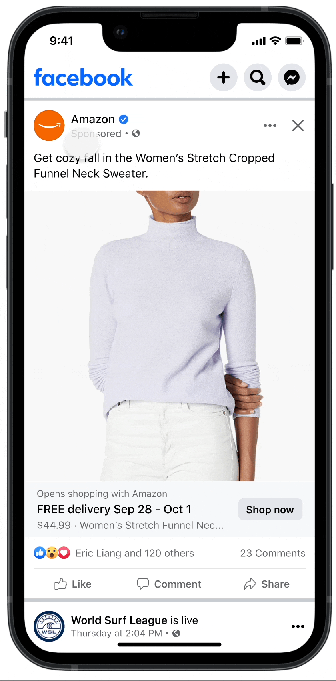
Image credit- TechCrunch
Users must complete a quick one-time setup in order to link their Amazon account to their Meta account (either Facebook or Instagram). Customers can easily make an Amazon purchase from the product ad after this is set up, without having to exit the Facebook or Instagram app. After that, the payment details and default shipping addresses that are saved on Amazon are used to finalize the sale.
Read More: Meta Contemplates Ad-Free Subscriptions, Targeting Indian Market
Benefits for advertiser
Users of Meta can now click on advertisements on Facebook or Instagram to visit a shop-like experience within the apps, making purchases simple and quick. Customers can make purchases using their linked Prime account without providing credit card information.
Improved ad signals: In order to boost customer investment, Meta receives more ad signals from the top online retailers and more attributed conversions.
Higher transaction fees: Due to its superior mobile discovery and ads engine, Amazon receives higher transaction fees than other retailers, which translates to more sales on its platform.
Increased conversions: With an extra sales channel and a 1:1 measurement between their most likely top ad platform and retail partner, merchants can increase the volume of conversions they generate.

Image credit- ITP Live
How will the in-app shopping feature help Meta and Amazon?
In an effort to increase ad revenue in the wake of Apple’s 2021 iOS privacy changes, Meta has decided to incorporate Amazon into its apps. It had an effect on both the digital ad market and Meta’s operations. However, the business recovered in 2023 following three quarters of declining revenue. According to Meta, the company’s investments in artificial intelligence have enabled it to attract retailers who are seeking to provide customers with personalized promotions.
Through their partnership, Meta and Amazon are able to profit from the benefits that each other offers. With its intent-based business strategy, Amazon can increase its market share. Moreover, it can assist retailers in attracting new clients who might not have actively looked for their goods. On the other hand, users can get targeted ads from Meta without having to actively search for them. This is thanks to its discovery-based business model. Data integration between the two platforms could be a crucial component of this. It includes Meta and Amazon sharing at least some insights that could better inform relative marketing strategies, ad performance, etc.
Amazon’s previous integrations
Amazon’s integration with Facebook and Instagram comes after a similar, mutually beneficial partnership between Pinterest and Amazon. Signed in April, the multiyear agreement between Pinterest and Amazon ads aims to increase the amount of shoppable content. Furthermore, it looks to improve the platforms’ selection of relevant brands and products. It also establishes Amazon as Pinterest’s first-party advertising partner. The collaboration may make it easier for customers to make purchases.
Here’s what they said
Amazon spokesperson, Callie Jernigan said
For the first time, customers will be able to shop Amazon’s Facebook and Instagram ads and check out with Amazon without leaving the social media apps. Customers in the U.S. will see real-time pricing, Prime eligibility, delivery estimates, and product details on select Amazon product ads on Facebook and Instagram as part of the new experience.
Read More: Meta Announces Five New Lead Generation, AI Powered Tools for FB, IG
Decoding Big Tech Giants Quarterly Results: Insights Await!
Big tech companies recently released their quarterly results for Q3 2023. Here are some key insights for industry enthusiasts.
ALPHABET
Alphabet, the parent company of Google, released third-quarter earnings that were above analyst projections. The business was satisfied with the quarterly results. The tech giant credited Cloud, YouTube, and Search for the overall boost. Out of all three, Search continued to be the key driver of their revenue expansion. However, Google’s Cloud business division failed to meet its revenue projections. Since Q1 of 2021, this has been the slowest documented growth in the Cloud business.
Because of this, Alphabet keeps investing in the cloud industry, which is growing in significance as generative AI emerges. YouTube’s advertising income exceeded experts’ forecasts thanks to increases in direct response and brand awareness. This is attributed to Shorts, the TikTok competitor of YouTube with 70 billion views every day.
By the numbers
- Revenue reported was $79.69B, up 11%.
- Google Search and other advertising revenues were $44B, a rise of 11% Y-O-Y.
- Google Cloud computing revenue rose 22% to $8.41B against estimates of $8.64B.
- Advertising revenue was up 9% to $59.6B as against an estimated $59.1B.
- YouTube advertising revenue reported $8B, up 12% Y-O-Y.
- Network advertising revenue was down 3% to $7.7B.
- Traffic acquisition costs were up $12.64B vs estimates of $12.63B.
- Search ad revenue was up 18%.
Google disclosed its quarterly results in the middle of its antitrust lawsuit. Government authorities claim Alphabet uses unlawful monopolistic methods to maintain control over its search engine. Additionally, it’s predicted that more advertisers will spend money on Google advertisements, which could lead to increased rivalry among them. In addition, Google keeps funding its attempts to develop Generative AI in an attempt to overtake its rivals.
Sundar Pichai, CEO of Alphabet, said in the earnings call,
I’m pleased with our financial results and our product momentum this quarter, with AI-driven innovations across Search, YouTube, Cloud, our Pixel devices, and more. We’re continuing to focus on making AI more helpful for everyone; there’s exciting progress and lots more to come.
Ruth Porat, President and Chief Investment Officer; CFO said,
The fundamental strength of our business was apparent again in Q3, with $77 billion in revenue, up 11% year over year, driven by meaningful growth in Search and YouTube, and momentum in Cloud. We continue to focus on judicious capital allocation to deliver sustainable financial value.
META
In terms of earnings and revenue, Meta exceeded the third-quarterly results. This was attributed to the increase in digital advertising spending. Exceeding expectations, the results showed the fastest growth rate, with revenues rising by 23%. Additionally, the company’s user base has grown in the face of fierce competition from rivals such as TikTok.
As its clients recover from a challenging 2022, Meta is witnessing faster growth in its core digital ads businesses. Right now, Meta’s business is doing better than its rivals. Its recovery can be largely traced to increasing the impact of its online ads. Additionally, Meta has cited its significant investments in AI as a crucial technological advancement that has enabled it to attract businesses seeking to serve clients with tailored incentives.
By the numbers
- Revenue rose 23% to $34.15B.
- Facebook DAUs were 2.09 billion on average, a 5% increase Y-O-Y.
- Facebook MAUs were 3.05 billion, an increase of 3% Y-O-Y.
- Family Daily Active People (DAP) was 3.14 billion on average, up 7% Y-O-Y.
- Family Monthly Active People (MAP) was 3.96 billion, higher by 7% Y-O-Y.
- Ad impressions across all Meta apps increased 31% Yo-Y and the average price per ad was down 6%.
Meta anticipates its spending in 2024 will exceed that as it continues to invest in AI infrastructure. Meta expressed a distaste for falling behind in the race towards generative artificial intelligence. To boost engagement, the internet giant intends to roll out AI-powered avatars on Facebook and Instagram. Users may be able to engage with the platform in new ways, receive recommendations, and do more with these identities.
Susan Li, Meta’s Chief Financial Officer stated that for Reality Labs, Meta’s augmented reality and virtual reality division, the company expects operating losses to increase meaningfully Yo-Y due to its ongoing product development efforts and investments to further scale the ecosystem.
Mark Zuckerberg, Meta founder and CEO said in the announcement,
We had a good quarter for our community and business. I’m proud of the work our teams have done to advance AI and mixed reality with the launch of Quest 3, Ray-Ban Meta smart glasses, and our AI studio.
MICROSOFT
Microsoft released the first quarterly results of its 2024 financial reports, and the company was off to a great start to the fiscal year. The favorable outcomes were ascribed to Microsoft Cloud’s strength, which outperformed analyst predictions. Microsoft completed its $68.7 billion acquisition of Activision Blizzard, a publisher of video games, earlier this month.
Microsoft claims to have the greatest AI infrastructure and the widest cloud footprint. Furthermore, compared to other cloud providers, it has more regions where AI services are installed. Furthermore, while search income growth was still influenced by third-party agreements, the rise in search and news advertising revenue was linked to higher interaction on Bing and Edge.
By the numbers
- Revenue recorded $56.5, higher by 13%.
- Microsoft’s Intelligent Cloud Unit revenues were $24.3, up 19% beating estimates of $23.4B.
- Azure revenues rose 29% against an estimated 26.2%.
- LinkedIn’s revenue increased by 8%.
- Microsoft Cloud Revenue was $31.8B, up 24%.
Microsoft is still dedicated to making investments in the cloud and AI potential. In order to increase consumer productivity, it is concentrating on quickly integrating AI into all facets of its technological and business processes. In addition, it will maintain strong growth in the upcoming year thanks to its leadership in the commercial cloud and AI platform wave.
Satya Nadella, CEO of Microsoft said,
With copilots, we are making the age of AI real for people and businesses everywhere, we are rapidly infusing AI across every layer of the tech stack and for every role and business process to drive productivity gains for our customers.
Amy Hood, Chief Financial Officer, Microsoft, commented,
We saw healthy renewals, particularly in Microsoft 365 E5, and the growth of new business continued to be moderate for standalone products sold outside the Microsoft 365 suite. In Azure, as expected, the optimization trends were similar to Q4. Higher-than-expected AI consumption contributed to revenue growth in Azure.
Read More: Delve Into What the Quarterly Results For Big Tech Titans Are Saying

AMAZON
Amazon outperformed analysts’ expectations and exceeded its own projections for the third quarter. Growing online sales in its retail section and significant cost reductions drove growth. Additionally, a notable increase in advertising revenue and growth in its cloud business, which kept stabilizing, were its main drivers. According to Amazon, the increase in AWS revenues of over $900M was offset by customers’ shifting focus towards fostering innovation and delivering new workloads to the cloud.
Amazon is still concentrating on buyer behavior and customer happiness. Thanks to the Prime Day event, when over 375 million goods were purchased globally by Prime members, Q3 revenues increased 11% YoY. The company’s introduction of generative AI capabilities into its products and services compensated for the decline in advertising revenue. Demand for daily necessities in areas like health, beauty, and personal care has remained high on Amazon.
By the number
- Revenue posted $143.1B, up 11% Yo-Y vs analysts’ expectations of $141.41B.
- AWS revenue was $23.1B, higher by 12% Yo-Y.
- Advertising sales jumped to $12B, rising 26%.
In addition to warehouse robots, which were already a prominent business for the corporation, Amazon continues to make large investments in generative AI. Further, AWS and Anthropic, Amazon’s generative AI, will work together on future advancements in AWS Trainium and AWS Inferentia chip technology, according to CEO Andy Jassy of Amazon. He thinks that the partnership will support the ongoing acceleration of the benefits to customers in terms of pricing and performance.
Amazon chief executive Andy Jassy said,
We had a strong third quarter as our cost to serve and speed of delivery in our Stores business took another step forward.
Brian Olsavsky, Amazon’s Chief Financial Officer added,
We’re ready to make this a great holiday season for customers. Overall, consumers have shown resilience in their spending despite rising interest rates and stubbornly high inflation that has steadily eased since last year. Amazon said Thursday its retail business grew by 6% during the third quarter. It was boosted by the company’s popular Prime Day sales event held in July. It’s also seeing strong customer demand across categories like beauty, health, and personal care items. But we still see customers being cautious about price, trading down where they can and seeking out deals.
He further added that as Amazon enters the holiday season, its operations network and inventory are in the optimal position like never before.
SNAP INC.
Snap INC. reported the third-quarterly results of 2023 and numbers that were better than anticipated by Wall Street. Its ad platform enhancements were the cause of the improvement in outcomes. For quite some time, Snap’s company has been in turmoil. This is because of TikTok’s rivalry, Apple’s modifications to iOS’s ad tracking, and a number of other issues. It was encouraging to see sales rise again. Moreover, Snap improved the ML ranking and optimization for the web, app, and Dynamic Product Ad (DPA) platform by implementing over 17 significant changes.
By the numbers
- Revenue posted $1,19B, up 5% from estimates of $1.11 B.
- DAUs 406 million, high 12% (43 million) Yo-Y.
- Snapchat+ reached more than 5 million subscribers.
By concentrating on investing in ML models to enhance content ranking and personalization across all content offerings, Snapchat is aiming to increase the depth of engagement with its content. Additionally, it will keep utilizing AI technology to provide the community with new services and goods. In addition, the business declared that over 200 million users have sent over 20 billion messages on My AI since its debut.
Evan Spiegel, CEO of Snap INC. said in the earnings call,
Our revenue returned to positive growth in Q3, increasing 5% year-over-year and flowing through to positive adjusted EBITDA as our reprioritized cost structure demonstrated the leverage in our business model. We are focused on improving our advertising platform to drive higher return on investment for our advertising partners, and we have evolved our go-to-market efforts to better serve our partners and drive customer success.
OMNICOM MEDIA GROUP
Beyond estimates, Omnicom revealed remarkable revenue growth in the 2023 third quarterly results. With consistent growth in media, advertising, and precision marketing, the business is still on track for the entire year. The outcomes follow significant recent victories, like the $600 million Uber media contract, which was transferred from competitor WPP to Omnicom Media Group in September.
With the release of Omni Assist, Omnicom’s customized version of ChatGPT that improves every task with Omni, it continues to develop its Generative AI capabilities. In addition, it keeps evaluating how Generative AI will impact Omnicom’s operations throughout the entire company and plans ahead.
By the numbers
- Global revenue reported $3.58B, a high of 3.3% or $113.1M organically.
- Advertising and media posted a 6.1% growth to $1.9B.
- Public Relations was down 5.5% against 12.6% delivered in Q3 2022.
- Third-party service costs increased $90.6M or 15.4% to $678.6M organic growth.
Omnicom is confident that its clients will receive the greatest creative skills and capabilities from the newly established Omnicom Advertising Services.
John Wren, Chairman and Chief Executive Officer of Omnicom stated,
We are pleased with our strong organic revenue growth of 3.3%, with notable performances in our Advertising and media, Precision Marketing, and Healthcare disciplines. Our year-to-date organic growth of 4.0% remains in line with our full-year expectations, which reflects the resiliency of our business even in periods of economic uncertainty. Omnicom continued to post strong profitability and earnings growth in the quarter, and our recent business wins validate the benefits of our client strategy in this rapidly evolving marketplace. We are very well positioned for a recovery in business conditions, with a strong balance sheet and leading creativity in all of our service disciplines.
Read More: OMG’s Rudra Khanna on Navigating Marketing’s Dynamic Landscape
Delve In What the Quarterly Results For Big Tech Titans Are Saying
The quarterly results for big tech companies are out. Here are some key takeaways for advertisers and marketers.
Microsoft
Microsoft’s fiscal year has been challenging on many fronts. The acquisition of Xandr, the ad-buying platform, and the increase in search volume revenues failed to produce satisfactory results, making Microsoft miss the mark in Q4. With continuous commitments to investing in artificial intelligence technologies, analysts predicted the quarter to be successful for Microsoft. The company attributed stagnant growth to a decline in advertising spending, which was lower than a quarter on quarter.
Its Talent Solutions contributed to the company’s revenue growth exceeding expectations. Despite the increased revenue, Microsoft reported a reduction in numbers due to low ad spending. The tech giant concluded it was due to marketing solutions decline. LinkedIn’s revenue increased due to growth in Talent solutions. Microsoft Cloud showed promising growth in all of its businesses with improvements in its verticals. Search and news advertising went up with the Xandr acquisition.
By the numbers:
- Revenue was up by 8% increasing to $56.2 billion.
- Advertising and news search revenues up to $86 million, a 3% increase including traffic acquisition cost, 8% increase excluding traffic acquisition cost.
- Azure Cloud revenue growth slowed from 27% to 26%.
- LinkedIn revenue increased by 5%.
- Microsoft Cloud’s quarterly revenue was 21% or $30.3 billion YoY.
Currently, the company is prioritizing developing and spearheading safe generative AI models and practices. Their aim is to help customers use Microsoft Cloud to make the most of their digital resources and drive operations control.
Satya Nadella, Chairman and Chief Executive Officer, Microsoft stated in the Q4 results announcement,
We remain focused on leading the new AI platform shift, helping customers use the Microsoft Cloud to get the most value out of their digital spend, and driving operating leverage.
Amy Hood, Executive Vice President and Chief Financial Officer at Microsoft cited,
Advertising spend was slightly lower than anticipated which impacted Search and News advertising and LinkedIn Marketing Solutions. For LinkedIn, we expect revenue growth in the low to mid-single digits.
She further added,
Even with share gains in our hiring business, growth will continue to be impacted by the overall markets for recruiting and advertising, especially in the technology industry where we have significant exposure.
Meta
Meta produced results in Q2 that exceeded analysts’ expectations. Revenues from advertising rose robustly. The revenue uptick signaled the social giant’s ad business recovery after previous years of gloom and cross-border concerns. Meta cited the increase in DAUs for Reels, the company’s short-form video content app. This attracts 200 billion people to Facebook and Instagram. The app also generated $10 billion annually, which is a $3 billion increase Q/Q.
The company credits the increase in ad revenues to Threads, the text-based app, and continued investment in artificial intelligence. The company ascribed the increase in ad impressions to a heightened focus on TikTok’s rival Reels and AI-driven products as the key factors in the positive outcome. Meta commits to AI advancements and data centers. The CEO has also highlighted AI as the focal point of Meta’s growth strategy. He predicts revenue from AI-powered structures for marketers, AI chat agents, and productivity tools for employees.
By the numbers:
- Revenue up to $32 billion, up 11%.
- Facebook DAUs are 2.06 billion on average, an increase of 5% year over year.
- Facebook’s MAUs of 3.03 billion increased by 3% year-over-year.
- Family daily active people (DAP) 3.07 billion on average, 7% up Yo-Y.
- Family monthly active people (MAP) 3.88 billion and 6% higher Yo-Y.
- Ad impressions in Q2 2023 increased 34% year-over-year and the average price per ad decreased 16% Yo-Y.
Susan Li, Meta’s Chief Financial Officer however stated that their ongoing commitment to invest in Reality Labs, Meta’s unit for metaverse-related initiatives negatively impacted their results. However, it will not hamper their ambition to spearhead metaverse developments.
Mark Zuckerberg, CEO of Meta added,
We had a good quarter. We continue to see strong engagement across our apps and we have the most exciting roadmap I’ve seen in a while with Llama 2, Threads, Reels, new AI products in pipeline, and the launch of Quest 3 this fall.
Alphabet
Alphabet, Google’s parent company overcame its advertising slump in the Q/Q, signaling a return to momentum with favorable results. The revival of their revenue graph was needed to reshape the competitive AI technology landscape. The Q2 results erased concerns about Google losing digital ad prowess to AI advancements on the financial forefront.
The company attributed the overall growth to increasing Google Cloud Services demand, which is anticipated to adopt AI as it advances. The rise in revenues can be traced to costs from YouTube subscriptions and the Pixel family’s content acquisition. YouTube witnessed a surge in stabilized ad spending despite competition from TikTok. Google Cloud revenues were up due to its AI-optimized structure which piqued consumer interest.
By the numbers:
- Revenue was $74.6 billion, up 7%.
- Ad sales rose 3% to $58.1 billion.
- YouTube revenues increased by 4% to $77 billion driven by brand advertising.
- Network advertising revenues were down 5% at $7.9 billion.
- Google Search and other advertising revenues were up 5%, to $42.6 billion.
- Google Cloud revenues are up 28%, at $23.5 billion.
Alphabet is certain that the money needed to finance AI advancements will come from Google’s advertising engine. As such, Google has predicted that it will face more difficulties not only from rivals like ChatGPT, Microsoft, and Bing but also from Amazon’s shopping unit and TikTok and Reddit in trending topics. As part of its efforts to strengthen cybersecurity capabilities, search, and advertising capabilities, the CEO mentioned that AI would be integrated across its product groups.
Sundar Pichai, CEO, said in the announcement,
There’s exciting momentum across our products and the company, which drove strong results this quarter. Our continued leadership in AI and our excellence in engineering and innovation are driving the next evolution of Search and improving all our services.
CFO Ruth Porat commented,
We expect elevated levels of investment in our technical infrastructure, increasing through 2023 and continuing in 2024. The primary driver is to support AI opportunities across Alphabet, including investments in GPUs and proprietary TPUs, as well as data center capacity. With all that said, we remain committed to durably re-engineering our cost base to help create capacity for these investments in support of long-term, sustainable financial value.
Amazon
Amazon released its second-quarter earnings, and the numbers were impressive. According to CEO Andy Jassy, Amazon saw developments in areas they had been steadily advancing in for the past quarters. The e-commerce giant attributes its revenue growth to the rise in price points, selections, and convenience available to its consumers. Amazon continues to see strong demand for everyday essentials, positive feedback from customers, and updates to its website, mobile apps, and customizations.
AWS growth stabilized in Q2. Moreover, it continues to grow with customers, partner networks, functionality, and operational presentation. AWS revenues were twice as high as any other provider. Amazon is constantly working to further AWS technologies and features to aid customers in leveraging generative AI, productivity, and security. Ad revenue increased due to performance-based advertising efforts, improved customer relevance of ads, and ML benefits to understand ROI and ad spending for brands.
By the numbers:
- $134.4 billion revenue, an increase of 11% Y-o-Y vs estimates of $131.5 billion by Refinitiv analysts.
- Advertising revenue is up 22% Yo-o-Y, to $10.68 billion.
- AWS sales revenue growth of 12% Yo-Y to $22.1 billion.
- Subscription service revenues including Prime memberships were up 14%, at $9.8 billion.
Amazon is currently working on enhancing Machine Learning models to help marketers access audiences that were difficult to reach with Amazon ads. During an AWS event in New York, Amazon also committed to enhancing generative AI-powered applications with the latest and improved pre-trained large language models (LLMs).
CEO Andy Jassy mentioned in the earnings call,
As the economy has been uncertain over the last year, AWS customers have needed assistance cost optimizing to withstand this challenging time. They have also needed assistance reallocating spending to new initiatives that better drive growth. We’ve proactively helped customers do this.
Apple
Apple reported their results for the third quarter that were better than their expectations, however, revenue was down Yo-Y. The company attributed the growth in its revenue to healthy iPhone sales across the world. Apple set an all-time high record for services revenues, including advertising, the app store, and music, exceeding its predictions. The slump in iPad sales revenue was accredited to the iPad Air launch in the prior year. They continue to invest in product enhancements to encourage customer satisfaction which was reported to be 98% across the U.S.
By the numbers:
- Revenue was $81.8 billion, down 1% Yo-Y.
- iPhone revenues are $39.7 down 2% Y-o-Y.
- $6.8 billion, down 7%, for Mac.
- iPad $5.6 billion, down 20%.
- Wearables home, and accessories revenues were $8.3 billion up 2% with expectations.
- Services revenue $21.2 acceleration of 8%.
Apple is releasing its most ambitious and advanced personal electronic device, the Apple Vision Pro early next year for ordinary consumers. It is currently only available to advertisers, content creators, etc for demo purposes and has received stellar reviews.
AI and machine learning will continue to be an integral part of product design. Apple is planning to introduce AI and ML-powered live voicemail in iOS 17. They have also invested in research into generative AI and continue to responsibly enhance their products with these technologies. This is with the goal of enriching people’s lives.
Tim Cook, Apple’s CEO said,
We are happy to report that we had an all-time revenue record in Services during the June quarter, driven by over 1 billion paid subscriptions, and we saw continued strength in emerging markets thanks to robust sales of iPhone. From education to the environment, we are continuing to advance our values, while championing innovation that enriches the lives of our customers and leaves the world better than we found it.
Luca Maestri, Apple’s CFO, further remarked,
Our June quarter year-over-year business performance improved from the March quarter, and our installed base of active devices reached an all-time high in every geographic segment.
Snapchat.INC
Snapchat reported its quarterly results and they were mixed. Although revenue was up Q/Q, it still saw a Yo-Y dip. Just like its competitors, Snapchat is grappling with a slump in advertising revenues. Snapchat also introduced an exciting and innovative AI feature a few months back to keep the platform happening and engaged. My AI, Snapchat’s AI chatbot is now integrated into group chats, recommendations, and ‘Lens’ suggestions.
By the numbers:
- Revenue was $1,068 million compared to $1,111 million the previous year
- DAUs 397 million, an increase of 50 million or 14% Yo-Y
- 4 million global users for paid subscriptions introduced in the previous year
This quarter, the social media company pledged to improve advertisers’ expectations through machine learning technology. It will do so to upgrade its framework, find creative approaches to measuring and optimizing ad spending, and encourage new leadership. Its continuous investment in ML infrastructure has improved company ranking and content personalization.
Snapchat believes that it will face healthy community growth in the next quarter with expected DAU increases of 405 to 406 million.
Evan Spiegel, Snapchat’s CEO said,
We are excited by the progress we have made delivering increased return on investment for our advertising partners, growing our community to 397 million daily active users, and reaching more than 4 million Snapchat+ subscribers.
Omnicom Media Group
Omnicom Media Group ended its second quarter of 2023 on a high note. The organic growth rate was up 3.4% compared to the previous quarter’s results, placing it within its projected range. Omnicom spearheads generative AI developments in the media business. Their ongoing strategic alliances with companies like Adobe, AWS (Amazon Web Services), and Microsoft help them do this.
The business has also promised to invest in media sales capabilities, environmentally friendly technology, and data from first parties. They are currently realigning their staff to match strategy choices and outlook.
By the numbers:
- 3.4% organic revenue growth in Q2 23, with $3,609.9 million revenue
- Advertising Media revenue growth was 4.2%, while organic growth grew by 5.1%
- Third-party costs which include supplier costs the company incurs when providing services to clients increased to $86.8 million
- Organic growth rate for Public Relations was up 0.1%, while execution & support decreased by 3.8%
John Wren, Chairman and CEO of Omnicom said in the announcement,
While the balance of the year will continue to see economic uncertainty, we are entering a dynamic and exciting new era for our company. Omnicom has secure leading positions in generative AI technologies and partnerships to deliver on our promise to achieve the best outcome for our clients and increase the operational efficiency of our company.
eBay
EBay has exceeded Wall Street’s expectations in all key metrics and delivered positive results. However, the marketplace’s weakened momentum among active buyers was worrying. Gross merchandise sales decreased also recorded.
In spite of this, the e-commerce marketplace believes that its increasing focus on AI integration into its platform will drive further user momentum. The company currently prioritizes laying a strong foundation for generative AI tools across the website to aid marketers and product listers.
By the numbers:
- Revenue was up to $2.51 billion, an increase of 5% from the previous year
- Advertising revenues were $367 million, up 33.5% Yo-Y.
- Promoted Listings revenue was up 47%, reporting $341 million
- The active buyer base declined by 4%
In the next five years, eBay plans to implement AI enhancements in every part of its organization. They are constantly integrating generative AI features into their site. They are also working towards reinventing the e-commerce landscape. Its work has already produced stellar results and hopes to deliver long-term results.
Jamie Iannone, CEO said,
The foundational work we’ve accomplished over the past 3 years has set us up for a new phase of innovation. Our teams are focused on thinking bigger and moving faster as we build game-changing features and functionality for customers to keep eBay at the forefront of eCommerce.
Read More: Advertise Your Brand in the Metaverse: The Future of Digital Advertising
How to rank well on Amazon? Performing SEO on Amazon
Introduction
It all started in the year 1994! A company named Amazon was founded and established in Bellevue, WA. During the initial years, the journey was not so smooth for Amazon. People around the world were not familiar with the online shopping experience and took them a series of the year to put their trust in the brand. However, soon the consumer and the market started realizing the potential of online shopping, the ease and effectiveness of ordering a product through an online portal. It was amazing how the world changed in the favor of Amazon and soon everyone was on the internet. It was not very long that social media came into picture and applications like Facebook and Instagram was launched. People started spending more time on the internet and the number of people utilizing the internet for their needs increased at a tremendous pace.
Even the brands in the market started realizing the potential of the internet. They showed interest in reaching to their consumers digitally and approaching them to purchase their products. People around the world found the method innovative and convenient and thus they started spending their time on different digital platforms on the internet. The advancement was unstoppable and soon the term digital marketing came into existence.
The digital market has seen tremendous growth in the past 10 years. As more traffic grows on the internet, the need to market the product to the right audience increases. People used different techniques to generate traffic on their websites. Some of the most common techniques used by people to generate traffic are:
- Search Engine Optimization (SEO)
- Social Media Marketing (SMM)
- Content Marketing
- Email Marketing
- Affiliate Marketing and many more.
The population of consumers on the internet is expanding at a tremendous pace. New brands are emerging to fulfil the needs of the consumers. Every day hundred’s of new businesses are entering the competitive world of marketing and advertising. All of them have something unique to offer to their customers. They are analyzing and developing an understanding of the current market trends. They are studying the existing scenarios and performing different tactics to attract customers towards their product. However, it becomes really difficult for new brands to make themselves visible to the right audience. Due to the changing trends in the market, it is hard to guess the next best step to predict the upcoming trends in the market. The uncertainty leads to the wrong strategy and sometimes to failure.
Brands use every possible technique to overcome the fear of failure. However, sometimes they make the wrong decisions in peer pressure and sometimes they hire the wrong people to work for them. According to a survey conducted by the Adscholars, nearly 90% failed businesses hired the wrong people to work for them which lead to failure. Therefore, it is always advisable to outsource your business to the pros, if you are unsure or uncertain of things.
Usually, the smaller brands do not have the adequate amount of resources to develop their team for digital marketing. Therefore, it is always advisable for them to hire help from outside. Outsourcing advertising firms have the right amount of experience and exposure to handle your business. Thus you can do research and find out the best outsourcing advertisement firm and pay them to get the job done. Trust me! It will save you a tremendous amount of money and effort.

blogspost
Amazon is the biggest shark of the e-commerce business around the world with only a few competitors. The biggest reason for the success of Amazon is that it started at the initial stage of the emergence of the digital world. Now it is providing opportunities to millions of people to sell their product on its platform. However, it is not a charitable organization and does charge a hefty fee on every transaction. Yet, people find it profitable to sell their product on its platform.
People have earned millions by selling their product on Amazon. The ease of selling provided by Amazon is admiring. With time using the right strategy, Amazon has gained the trust of its consumers. Amazon realized the true potential of the consumer market and it makes them comfortable in their homes. Now, a consumer does not need to leave home to purchase things that are required by them. All they have to do is move their fingers on their phone, explore through the wide range of products listed online and hit buy now! And just like that your order is placed and delivered to you with the most secure and fastest delivery around the globe.
Understanding the algorithm of Amazon

Marketing Land
Before you start selling your products on Amazon, it is crucial that you understand the working of its algorithm. Getting to know the algorithm of Amazon will give you an edge to sell your product more effectively to your audience and you can devise a better strategy to sell more and you can be visible to the right audience at the most opportune time. It will also help you to improve your ranking among your competitors.
Amazon algorithm which is also known as A9 is a bit complicated. However, it is highly effective and it works flawlessly. Amazon algorithm is the reason the company has managed to achieve such a huge user base with sellers having the ease of doing the business.
The algorithm(A9) is named after its creator and it is the engine responsible for driving the Amazon to the top. A9 is a customer-centric algorithm and is designed to flash products which are best in terms of selling, having a great margin and provided by the sellers who value their customers. Therefore, if you want to be visible to your customers on Amazon, you have to make sure that you keep these three factors in mind.
It even allows the sellers to develop and set their algorithm to serve their customers more effectively. Recently, Amazon has made some effective changes in its algorithm getting more customer-centric. Hence, some people have started calling the algorithm A10 after these updates.
You do not have to be a programmer to understand the working of Amazon algorithm(A9). You can just get a basic idea of its functionality and plan your strategy accordingly. Here are the few basics that you must look into before setting up your store on Amazon and listing your products:
- A9 is a basic formula developed by the company to arrange the products according to the customer’s search and their preferences. It scans the products, reads through the descriptions, and analyzes the data attached to the product which is listed on Amazon’s marketplace. It is based on the technology of artificial intelligence(AI) and thus, works independently and smartly.
- The algorithm is smart and makes sure that it goes through the history of the customer’s last journey before presenting the customers with new preferences.
- The products which are placed on the front line are the best selling products on the platform, having an adequate margin and sold by the seller who has a customer-centric approach( Good service, value for money, on-time delivery and better return policy.)
- This is nothing new, mostly every eCommerce website has a similar algorithm placed in its core. However, Amazon keeps on evolving and always making the algorithm better for its customers.
- Four crucial metrics contribute to a better listing on Amazon. These factors are looked by the algorithm in specific detail before placing the product in the list:
- The number of sales the seller has done so far and the revenue generated.
- The relevance of searched keywords by the customer.
- Best price for the product.
- Availability of the product.
By following these simple observations, you can design a better campaign for your products and brand.
Key factors responsible for the ranking on Amazon

Pc Magzine
As we have stated above, the algorithm of Amazon is customer-centric and the more effective and efficient you are with your customers. There are better chances of you ranking in the top list. The four crucial factors that are responsible for the front line listing are:
- Sales: The algorithm analyzes your sales channel on the bases of your sales and value generation on the platform. It looks into your performance so far based on the dollars that you have earned for yourself and the platform.
- Relevant description and keywords: Secondly, it looks for the keywords that you have entered into your listing. The more relevant it is to the searched terms by the customer, there is a better chance that the algorithm will choose your product to be shown as the front line of the results.
- Pricing: When pricing your product you must pay extra attention and it is always advised to have a strategy for the pricing of your product. Most of the brands fail in business due to their poor pricing strategy. Several pricing techniques are available, some of the most crucial pricing techniques are:
Competitor based pricing technique: The formula for pricing your product based on this strategy is:
Competitors Price = Your Product Price.
Cost-plus Pricing technique: The basic formula for calculating the pricing for your products using this strategy is:
Cost Of Production + Margin = Cost of the final product (Cost-Plus Pricing).
Value-based pricing technique: This is the best strategy to price your product. According to the technique, you must price your product only after performing thorough market research and analyzing the value by checking every possible factor that can influence the pricing of your product. The formulae for pricing your product according to the value-based pricing is:
Value of the product = Brand Advantage + Value of Product
Therefore, it is important to note that if your brand does not have an advantage of popularity, you must charge the customer only for the value of the product.
Benefits of SEO

Sellbrite
SEO or Search Engine Optimization is the most crucial aspect of digital marketing. The technique helps you to stay visible to your audience, leading to high traffic on your page and website. It helps you to increase the credibility of brand and products and make you popular in the market.
For example, whenever we search something on Google, we only see the tops 10-20 results. Even though there may be a million more similar search results but we stick to the top results as we only trust them to be appropriate and related. Similarly, the top 3-5 results or links are among the most visited. This is because we don’t trust the credibility of other results shown by Google.

Image Credit: CNBC
Similarly, if your website is listed and ranked among the top 5-10 search results on any search engine, there are high chances of people visiting it and trusting it for their work and even for purchasing products online. Hence, we provide you with several reasons why SEO can prove to be fruitful to your business.
- Better experience for the users: The users of the internet holds utmost importance in providing growth and revenue for any business running online. Therefore, it is crucial that you provide optimized and better experience to the users.
- The best source to generate leads: By optimizing your website or web page with SEO, you can generate leads effectively. The method has proven to be a sure shot success and helped millions of businesses to achieve unexpected targets in their businesses.
- Higher rate of conversion: The method not only helps in generating leads but also prove an asset when it comes to conversion. If you are looking to achieve high targets in your business, SEO can be the one good option that you can invest in wholeheartedly.
- Cost-efficient: Instead of investing hundreds of dollars on outbound resources, SEO can help you get inbound traffic and save all the extra money and investment that you will spend on outbound teams and data.
- Helps in getting physical customers to your stores: There is a higher chance that people who will see your store and website on the internet will visit your store or outlet physically.
- Increasing brand credibility: If you have a better rating and user traffic on your website, it will automatically boost the credibility of your brand.
- Created awareness for the brand: SEO is useful in creating brand awareness and will help your brand flourish in the market. The results and outcomes achieved by this technique are far more superior than any other method in the market.
- Makes your website mobile-friendly: SEO helps in optimizing your website according to the mobile interface. As most of the customers are using their phones to access the internet these days, it proves to be highly profitable in generating leads and in the process of conversion.
- A long term strategy for marketing your product: SEO proves to be a long term strategic approach and helps in expanding business over the years.
- Helps in establishing your business on social media platforms: The tool is useful for mobilising your business on social media websites like Facebook, Instagram, Twitter and other useful platforms.
How to perform SEO on Amazon?
As Amazon is the big shark of the eCommerce market, it becomes important to understand how to perform SEO on its platform. There are almost ten-millions items listed on the platform and making your product outshine them all is very difficult. However, you can achieve this goal by performing SEO.
Just like any other SEO performed on search engines, it is easy to perform SEO on the platform of Amazon! You can use the technique of SEO on Amazon to make yourself visible to the audiences. Like any other search engine, customers use the search bar to search their queries on the platform. The algorithm of Amazon makes sure that it provides the user with the most relevant results by searching its catalogue through different categories.
In research conducted by Adscholars, it was found that if the searches are relevant, customers won’t even pass the first page on the website. Therefore, it is crucial that the products are described and the keywords are placed appropriately.

It is important that we set our priorities right, the reason to use the platform of Amazon is to sell products. Amazon wants to strike the perfect balance between the customer and the seller. It wants the customer to be happy and the seller to earn more money by bringing back the customers to the platform for every purchase that they make.
Keywords are the most crucial factors that will affect your listing on the platform. Therefore, it is crucial that you place them correctly and according to the relevance of the product that you are selling. We will discuss more the usage of keywords on the platform in the upcoming headings.
What not to do when performing SEO on Amazon
People often tend to get carried away while listing their products on eCommerce websites and they tend to overdo things to make sure that they rank well! However, overdoing things results in poor ranking as the algorithm is not able to determine the correct path for your product.
People usually write lengthy, irrelevant descriptions for their products in the listing which leads to improper search results by the platform and the products lands to get poor ranking in the list shown in the search results.
As we have mentioned, keywords are the most crucial aspect if you are willing to improve the ranking of your product in the listing. Therefore, it is highly relevant that you place the right keywords in the listing of your product. For example, a product “ Frypan” should not be labelled as “egg pan” or “ Pancake maker” in keywords as it can lead to confusion for the algorithm and the product will not be listed in the top searches if someone is looking for a “ Frypan” in particular.

Therefore, it is always advisable to keep your keywords simple and relevant according to the description of your product.
Also, you must not try to spam the algorithm by putting any fake links or by providing fake rankings to your competitors. These shortcut methods can put you in huge trouble and you might end up losing your credibility on the platform. There are high chances that your account might get suspended due to foul play or behavioral misconduct.
Performing keyword research
Performing keyword research is a crucial part of the listing of the product. There are hundreds of tools available in the market that you can use to see the most appropriate searches made by the people on the internet for any particular product.

Wordstream
You have to be particular when putting the keywords in your listing. The algorithm on the Amazon platform also checks for the bounce-back time of the customer. Let us say that a customer clicks on your listing but leaves quickly after exploring the items. This will raise a doubt in the mind of the algorithm that probably the item is not relevant to the search result. Therefore, there is a huge chance that the platform will not show the same result in the future for the searched keyword and it will skip your product due to irrelevance.
Hence, using the right tools and placing the right keyword is very crucial.
Some of the best tools available for searching the keywords are:
- Amazon keyword tool
- Google Keyword planner
- Keyword tool
Also, the title of the product must be crisp and clear. It will help the algorithm to have a better understanding of your product and you will be able to grab the best rankings on the list.
Using Amazon keyword tool for searching relevant keywords
If you are willing to use the keywords for the SEO of your products on Amazon and looking for keywords, we would recommend you to use the Amazon keyword tool for the best keywords. It is the best way to find the most relevant keywords for your listing on Amazon.
Here, you must understand that Amazon is not just a selling platform. It is a smart selling platform which is innovative and not traditional in its approach. It provides every possibility for the seller to help enhance the selling experience for their customers. By providing efficient tools and techniques to its sellers, it helps Amazon to increase its credibility in the market, and it has proven to be highly effective for the company so far.
You must understand that keywords are not just for SEO. Keyword proves crucial when you are looking for the conversion on the platform. Planting the right keyword in your listing will not only help you to increase the traffic and appear in listings, but it will also help you to generate the right traffic for your product which will have the greater chance of a conversion.
If you are unfamiliar with the conversion rate and do not know how to calculate it for your brand here, we have the formulae which will help you to calculate it the right way:
Conversion rate = Number of sales/ Number of page views x 100
Achieving a high conversion rate is crucial. You must understand that a greater conversion rate is fruitful for both revenue and credibility of the brand. It will help in increasing the visibility, relevance and conversion of your brand and products.
One of the best ways to achieve them is keywords. As the algorithm A9 gives special importance to the factor!
Amazon already has the largest user database. All you have to do is utilize it effectively. However, if you perform the SEO for your products there are chances that you can increase the proportion of your sales twice in just a few months’ time frames.
To use the tools for keywords on Amazon, you can download extensions like KDSPY, which is a valuable tool working effectively with the platform. Then you can search for the desired product on the tools and lookup for the conversion rate for the similar products, variation in prices, the keywords that are used in their listing and also check the best titles and modify them for your product.
Utilizing the Amazon search bar for keywords search

Amazon
Amazon’s search bar is itself a magnificent tool for performing keyword research. It is always advisable to look for related keywords in the search bar to obtain the best efficient ranking on the platform.
Every time you enter something in the search bar of Amazon, it starts populating with related phrases that people search using those terms. These search terms are useful for both; consumer and seller. These search options are visible in the drop-down suggestions on the platform helps a consumer to search for the relevant product. Whereas, it helps the seller by assisting the customer to make the right decision while searching for products. The target automatically leads the consumer to the right path.
These suggestions are highly useful while performing SEO on Amazon. You can utilize these suggestions in the search bar as keywords, and the algorithm will choose your product as per the relevance of the products. As these suggestions are provided by the algorithm itself, there is a huge chance that putting these keywords in your listing will help your product to make the cut of top 10 relevant products on the first page.
You can try the same by searching for something in the search bar. For example: As soon as you enter “T-shirts” in the search bar, it will provide you with suggestions like “T-shirts for men”, “T-shirts for women”, “Round neck T-shirts”, “Polo T-shirts”, “Cotton T-shirts” etc. Thus, you can use these suggestions as your keywords, if you are selling t-shirts on your store at Amazon. You can perform similar searches for other products as well!
Optimizing your product listing
An optimized product listing can do wonders on Amazon. A well-optimized listing has a higher chance of being visible in the top 10-20 items. As we all know, no one wants to scroll through 100 pages to find the right product. People only check for the first few pages, and if they do not find what they are looking for, they go to the search bar and try a different search keyword for searching the same product. Thus optimizing the product listing can help you to achieve the milestone of being the best seller on the platform with millions of customers visiting your listing daily.
Here we have the appropriate optimizations that you can perform on your listing to get the best results for your channel and store on Amazon:
- Optimize your store by using the techniques of SEO. If you are unable to perform SEO efficiently, you can always outsource SEO to digital marketing agencies who are experts in the field.
- You should optimize your product for all Amazon platforms i.e. Amazon business, Amazon Prime and Amazon for consumers.
- You should perform optimization on the pricing of your product and offer discounts in your listing prices.
- Optimizing the inventory and shipping method for your products can do wonders for your brand.
- Review management is paramount to achieve the goal of being the best seller on the platform.
- Investing in sponsored product ads has proven to be highly effective. In a survey, it was found that almost 55% of people visiting the platform click on the sponsored product advertisement. It will increase the viewership of your new product or an existing one.
An appropriate title for the products
The title is the first thing that a consumer notices while checking the product in a list. Amazon’s algorithm also looks for the most appropriate title matching the search term of the consumer. Therefore, one must pay undivided attention to the title.

By exploring the listings on Amazon, you will realize that people usually tend to write long length titles for their product. However, we would say that it is not the perfect way to put the title.
The title of your product must be crisp and bold to attract the attention of the customer. It needs to be relevant to the products, and you must not stretch it to lengths to prove your point. Also, you must include the primary keywords for your products in the title. It will make your products more visible to the algorithm, and it will pick your product on priority when the relevant keyword will be searched.
The title must be short as you get the description part in your listing to describe your product.
Describing your product
A product description is a vital part of the product listing. One must pay extra care and ensure that all the essential information is presented to the customer. The description of the product is the most significant part of any product and investing attention while you work on the description is essential.

eBay
Following these few vital tricks, you can see the increase in the credibility of your product. However, if you are finding it difficult to put your efforts into product descriptions, you can always outsource the work to the professionals. People usually hire professionals for writing the description, as it gets a little tricky when you have to explain the details of your product in just a few words. However, if you are working on the descriptions for your products on your own, here are a few things that you must remember while describing the product.
- The description must not contain any unnecessary information. For example, avoid adding details of things that you have already mentioned in other fields like the color of your product.
- Avoid writing long paragraphs and try to break things down into bullet points. It will help you to explain your product effectively to the audience, and even the audience will have a better understanding of the products.
- Use keywords in the description field. It will increase the relevance of the keywords and will help increase the overall ranking of the product.
- Avoid answering questions while describing your product. You have the column for FAQs which can be utilized to address the most inquisitive questions of the customers.
- Try being more verbal about the quality and superiority of your product. Highlight the USP’s of your products which will help you to sell your products better.
Assigning keywords for the backend search
Backend listing plays a crucial role in providing growth to your products and brands. Therefore, it is vital that you optimize both; front end and the backend product listing of your products. Though the backend listing is not visible to your customers, the algorithm A9 has full access to your backend listing, and it is a decisive factor for the ranking of your products and brand.
Before the year 2015, the word limit for the characters per field was merely 50. However, with the evolution of time and the growth of the platform, Amazon lets you include 1000 words in a field. Therefore, including keywords in these fields can help you rank better on Amazon. This way you can optimize your backend listing effectively.
Although, there is much space to write a description in every field you should refrain yourself from doing so. Writing irrelevant details can damage the chances of growth on the platform. However, you can include long-tail keywords which will help you to gain effective ranking on the platform.
Importance of user reviews on Amazon

assets
User reviews hold the utmost importance on an eCommerce selling platform like Amazon. Positive user reviews can help your brand rise to the top in just a few months, and the negative ones will damage the image of your brand in a similar timeframe. Therefore, it becomes very crucial that you work efficiently on customer satisfaction. The satisfaction of the customer can be achieved by providing them with a great service which includes
- On-time delivery,
- Quality of product,
- Describing the product correctly,
- Making no false promises,
- Easy return policies,
- Listening to their queries and answering them with all the best possible solutions,
- Working on their complaints with a wholehearted resolution approach and
- By going an extra mile for the customer.
However, it is not possible to always get a positive review by every customer. If you can achieve such conditions then there is no stopping you! But, it is not realistic as there is always an unsatisfied customer who finds something wrong with every perfect product. Therefore, if you also have such unsatisfied customers who are putting negative reviews on your store, you can deal with it by the following two methods:
- Resolve their issues and once resolved, request them to remove the negative feedback: This is one of the most effective ways of dealing with the negative reviews. It helps you to address the issues of the customer first hand and build trust towards your brand.
- Addressing the issues by writing back to the customer: Even by addressing the issues you can gain the trust of customers. When some other customer will see a negative review and will see that you tried to address the issue in a reassuring way it will help him to put trust on you looking that at least you tried your best to resolve the issue. Therefore, you must confront every bad review and build the best strategy to deal with it positively.
Following these techniques will help you in increasing the credibility and brand value.
Amazon Q4 trends in 2020
The Q4 or the festive season brings numerous opportunities for every seller and customers. There is an accelerated flow of traffic during this quarter, and Amazon is known to generate high revenue during this time frame. Therefore if you have yet not decided a strategy for the Q4, you must do it quickly and start a campaign for this exciting season of revenue generation.

amazon
“In economics, things take longer to happen than you think they will, and then they happen faster than you thought they could.”
— Rudiger Dornbusch, Economist
Due to the pandemic outbreak across the globe, the market has seen a tremendous shift towards online shopping platforms. People are opting to stay home and purchase their goods and items over the internet. Therefore, this year revenue generated by Amazon is expected to hit a higher curve as compared to the last few years. Hence, you should buckle-up as the roller coaster of revenue generation is going to hit its highest speed this quarter.
This year anticipation shows that there will be a huge increase in new customers which can even go up to 7.4 billion. Yes! That is a huge number and amazon being the most trusted platform for online shopping among consumers you can expect a huge crowd turning towards the platform for their needs.
This is not limited to just the festive season, as most countries are still fearing to be hit by the second wave of the pandemic and imposing lockdown larger retail brands like Walmart are also shifting their business online to serve their customers better.
According to a few pieces of research conducted online, nearly 43% of the worlds total population is shifting towards online purchasing due to the pandemic breakdown. Hence, a strategy must be adopted to get the best out of it. Here are a few points that you can consider in your while making a strategy for this quarter:
- Offering discounts: Offering discounts is the best strategy to attract customers towards your products. People are compelled to purchase products at discounted rates.
- Describing your product clearly: A well-described product has more chances of selling than a product with distorted information. You can also mention the details about its usage and its USP to make the description more attractive.
- Combo offers: You can create a combo of products and provide them on discounted prices. It can prove to be an attractive way of selling more products.
- Resolving the queries of consumers: Customers queries must be resolved, on a priority basis. An unsatisfied customer will provide you with a poor review and rating, which will decrease your chances of selling better.
- Travelling the extra mile for the customer: It is always good to do a bit more than expected by the customer. If you make sure that you provide the customers with a bit more than they are expecting from the product, it will help them feel special and eventually increase the value of your brand. For example, you can include a pair of 3-layer masks or a small bottle of sanitizer with every package that you ship. This small gesture will make your customer feel special and cared and will ultimately lead to good reviews and increased credibility.
Conclusion
If you are planning to expand your business online the time is most opportune. People are shifting their focus from physical stores to eCommerce. One of the biggest factors for this change is the current Covid outbreak which has forced people to stay indoors and make their purchase online. However, it has proven to be a fruitful situation for online sellers.
Amazon is the biggest market for online shopping and includes a wide category of products. It has gained peoples trust over the period, and now people prefer it for their day to day purchase. Thus, setting up your store on Amazon can prove to be highly beneficial for the sellers as they will automatically have heavy traffic of customers.
However, it is not easy to sell your product when there is already a wide range of products available online. Therefore, you must devise a strategy so that you can achieve the spotlight among thousands of competitors. Price of a product plays a crucial role in selling a product. However, there are several other factors which can help you sell better on the platform.
SEO or search engine optimization can help you achieve your targets easily and effectively. The technique includes several steps which have been explained above. However, if you are unsure or uncertain about the techniques, you can always seek out for help.
Outsourcing business is always fruitful as it allows you to share your workload with a trusted team which will help you grow. Outsourcing your business is easy! All you have to do is find a perfect partner who can help you in your endeavors.
At Adscholars, we believe in understanding the emotions and feelings of a person attached to the business and accordingly devise a strategy which supports the value and policies of the business. We have a high success rate, and we keep ourselves updated with the latest trends and techniques of the market. Our team consists of highly trained professionals who have been working and reshaping the demographic of Digital marketing.
— Rudiger Dornbusch, Economist
–>
Amazon Announces AWS Clean Rooms To Boost Adtech Growth
AWS launched a new service that will help customers and their partners inside an advertising or marketing organization share, analyze and collaborate on combined datasets without running the risk of revealing personal data. With AWS Clean Rooms, customers can create a secure data clean room in minutes and collaborate with any other company in the AWS Cloud to generate unique insights about advertising campaigns, investment decisions, clinical research, and more.
Amazon intends to capitalize on its success as a digital advertising platform as it foresees a void in data capabilities for advertisers when Google deprecates third-party cookies later next year. During the Amazon Ads Unboxed conference, Amazon highlighted the product as a homegrown data clean room. AWS clean rooms and planned identity resolution tools target brand marketers, agencies, publishers, and martech companies to provide purpose-built services.AWS Clean Rooms also includes advanced cryptographic computing tools that keep data encrypted, even as queries are processed, to comply with stringent data handling policies.
How does it work?

Credit: AWS
AWS data clean rooms explained
Data clean rooms are protected environments where multiple parties can collaborate and analyze data without revealing raw data. Amazon is also enabling customers to leverage clean rooms by addressing the old-school way of data sharing.- one company often has to provide a copy of their user-level data to their partners and rely on contractual agreements to prevent misuse.
They are hard and expensive to build, require complex privacy controls, and specialized tools to protect each participant’s data, and are time-consuming in customizing analytics tools. After building up a data clean room, it needs constant data updates for new collaborators and data types. Amazon is addressing these challenges with AWS data clean room. AWS allows 5 parties to collaborate in one collaboration.
For instance, an automotive brand with customer loyalty data can collaborate with another brand that has data on a user’s ad-clicking behavior for better insight and user experience. The idea is for brands and media publishers to set up a clean room and collaborate over data in a few clicks than spending time to build it. Companies collaborate, and contribute their data in any type while protecting the underlying data using configurable controls.
The company emphasizes the importance of sharing data for improving the effectiveness of advertising campaigns. In the future, third-party cookies will disappear, whereas tech giants like Apple will give consumers more control over their data privacy giving them more knowledge about how their data is being used.
Identity Resolution
In the coming months, AWS will also introduce new identity resolution capabilities to help businesses match and link customer records stored across disparate channels without the need to build and maintain complex workflows. The press release stated that with identity resolution capabilities, customers can create a unified view of their interactions with consumers. Companies who want to collaborate with other partners in a clean room can use automated identity resolution workflows that identify common user IDs across datasets and help them more easily join data together.
AWS Clean Rooms is available as a standalone offering and as part of AWS for Advertising and Marketing. It will be available in early 2023 on the U.S. East and West coasts as well as parts of Asia Pacific and Europe.
The Amazon Marketing Cloud
Amazon Marketing Cloud (AMC) is a secure, privacy-safe clean room application from Amazon Ads on Amazon Web series infrastructure. Marketers can use it for custom analytics and cross-channel analysis. Builders can utilize AMC APIs to create their own offerings, while analysts can interact with a user interface available through the Amazon Ad Console.
AMC’s core value proposition is its ability to ingest both in-store and direct-to-consumer sales. In Amazon’s clean room, this data can be integrated into analytics reports for advertisers to understand total sales and which channels are generating incremental sales. Paula Despins, vice president of Ads Measurement at Amazon Ads said,
“Providing marketers with greater control over their own signals, while being able to analyze them in conjunction with signals from Amazon Ads, is crucial in today’s marketing landscape.”
“By migrating AMC’s compute infrastructure to AWS Clean Rooms under the hood, marketers can use their own signals in AMC without moving data out of their AWS environment. This simplifies how marketers can manage their signals and enables AMC teams to focus on building new capabilities for brands.”
How clean are clean rooms?
There is a lot of debate around data clean rooms safety and security and remains an open question. Programmatic landscapes are evolving, and clean rooms are just one part of them. Insider Intelligence shows that 37% of media owners and agencies respectively are increasing their investment in clean rooms. Earlier this year, Omnicom, Roku, and Disney launched clean rooms.
Security concerns arise despite the fact that they do not reveal private customer information. Thus, businesses must ensure that they adhere to consistent security and privacy rules or risk consumers calling them out. Thus, businesses must ensure that they adhere to consistent security and privacy rules or risk consumers calling them out.
More to Read: Clean Rooms Explained: How Marketers Can Prepare For Cookieless World
Amazon Unveils New Video Advertising Solutions
Amazon unveiled a slew of new video advertising capabilities at its Unboxed event. A bright spot for the retailer in the midst of economic uncertainty is its highly profitable advertising revenue. Alan Moss, VP of Global Advertising Sales at Amazon Ads in a statement,
“We have to provide our advertisers the flexibility, efficiency and scale to be nimble and responsive as their needs change.”
These include features like campaign presets, campaign recommendations, and video creation tools. Tanner Elton, vice president of U.S. sales for Amazon Ads said in a statement, “We want to bring the power of video advertising to more brands, no matter their size or level of resources.” Here is a quick overview of 7 new features and programs follows:
1. Rewarded Sponsored Display
Brands can add an Amazon shopping credit directly into the Sponsored Display creative. Customers receive the reward by clicking on the ad and purchasing the featured product. This is an expansion of the rewarded ads already available across various placements, including Twitch and Fire TV.
Business owners that sell products and services in verticals that Amazon doesn’t carry, such as restaurants and hotels, can now use Amazon’s Sponsored Display ad product to market to Twitch viewers. The interesting part to note is it is available only to Sponsored Display Ads and not Sponsored Product Ads. The feature will soon roll out to U.S. advertisers in closed beta.
2. Sponsored Display for non-native brands
Amazon Ads is introducing Sponsored Displays for brands that do not sell in Amazon’s stores. This is currently offered to US advertisers in closed beta on Twitch. Previously, sponsored ads had only been available for brands that sell products on Amazon. Now, businesses that sell products and services in verticals not available on Amazon, like restaurants and hotels, can use Sponsored Displays to reach the highly engaged Twitch audience.
This is currently offered to U.S. advertisers in closed beta on Twitch. There needs to be more information regarding when or if this will apply to Amazon.com on-site placements and other owned media properties. If it does then this could be an excellent opportunity for non-native brands. Amazon’s increasing focus on revenue generation beyond its own ecosystem could pave the way for bigger opportunities in the future. Existing advertisers will face competition, which will lead to an increase in Amazon’s auction-based bidding costs.
3. Sponsored Display video creative
Sponsored Display video creative available worldwide empowers advertisers of all sizes, particularly small and emerging brands, to easily create video campaigns that showcase their products and stories to millions of customers on Amazon and elsewhere online. Advertisers can deliver immersive video ads—such as tutorials, demos, unboxing, and testimonials—and measure campaign performance with new video metrics.
4. Digital Signage Ads in Amazon DSP
Amazon Ads is enabling a new inventory opportunity for brands to create campaigns on Amazon DSP to run in physical store digital signage, allowing customers to view or engage with a brand in a physical environment, at the time of purchase. It will be available in November to eligible US advertisers via managed service, making it easier for brands to advertise within Amazon Fresh stores. With Digital Signage Ads in Amazon DSP, brands can now purchase ads programmatically, giving them more flexibility and control over where their ads are featured.
Campaigns can be scheduled based on store location, by daypart, or by location of the digital signage within the store. This creates more opportunities for brand discovery and will enhance the customer shopping experience by creating a wider variety of in-store ads. Amazon should roll this feature to other big stores like Whole Food stores and more placements in the DSP.
5. Sponsored Products campaigns with presets
Advertisers can now launch new Sponsored Products campaigns with preset campaign settings such as daily budget, bidding strategy, targeting strategy, and associated bids. With this feature, advertisers will see recommendations on how to set up performant, ready-to-launch campaigns—saving time and helping drive results from the onset. Amazon Ads found that campaigns launched with preset observed a 77% increase in clicks, and a 29% increase in conversions compared to campaigns that did not utilize presets.
This feature helps advertisers identify potential candidates for advertising and provides all the campaign settings tailored to the product being advertised. This is suitable for the launch of new campaigns that require high bids to attract traction. However, one has to trial and test to know the results.
6. Performance recommendations
Performance recommendations are in-console, actionable best practices for Sponsored Products campaigns. As advertisers browse the advertising console, performance recommendations work in the background, constantly looking for recommendations that can be adopted with one click such as new keywords and updated bids. This gives advertisers in-the-moment feedback to improve campaign performance based on rigorously tested and validated best practices.
7. Amazon Marketing Cloud (AMC)
In ad-tech, Amazon highlighted its Amazon Marketing Cloud, a data clean room solution, at UnBoxed. Increasingly, marketers are looking for clean rooms as third-party cookies are deprecated. The company is focused on improving signal coverage and ease of use. AMC now offers Sponsored Display and digital subscription events, pre-built instructional queries, and the ability to manage DSP audiences. Keerat Sharma, director, Amazon Marketing Cloud, and Ad Tech Solutions said,
“We are constantly thinking about how we can better help marketers, particularly as they grapple with accurately measuring campaigns and adapting to the changes happening in digital advertising. Offering more actionable insights and increasing interoperability across our ad tech suite are examples of how we’re building to help brands operate more efficiently and make more informed business decisions.”
Furthermore, Amazon touts its Amazon Marketing Cloud (AMC) clean room service, which supports more flexible analytics and enables marketers to build their own ad tech solutions. Over the past year, AMC’s active customer base has quadrupled.
The tech giant also expanded CTV Integrations and Metrics. CTV advertisers on Amazon will now be able to see how valuable their audience is with the company’s new “incremental household reach” feature. Brands will be able to measure the unique, incremental audiences that were reached by Amazon streaming TV ad campaigns, in addition to those reached by linear TV ads.
Additionally, brand selling on Amazon can feature a variety of interactive video ads that feature CTA options such as “Add to cart,” or “Shop now.”. Off-Amazon brands can include an opt-in CTA “Send me more” and provide follow-up information.
Interesting Read: The Journey From Deterministic To Probabilistic Marketing

